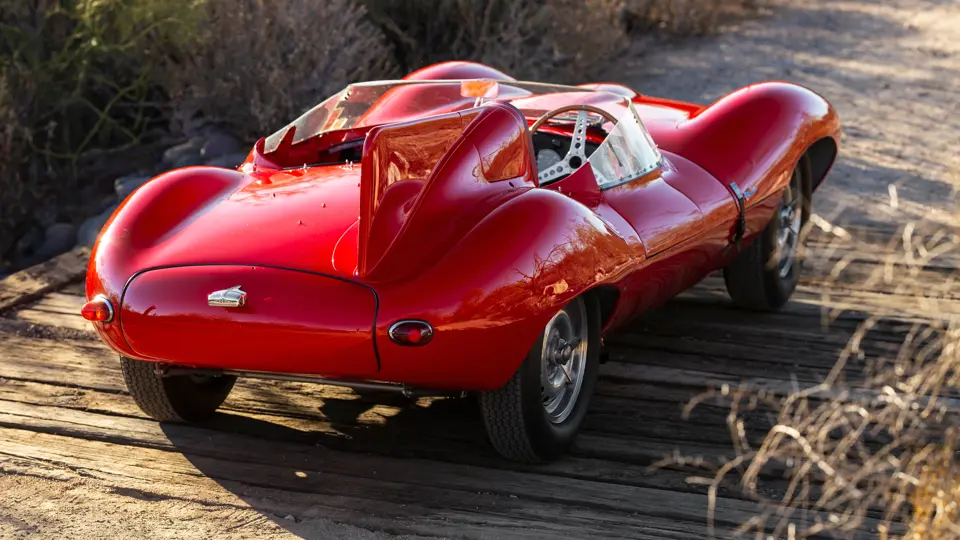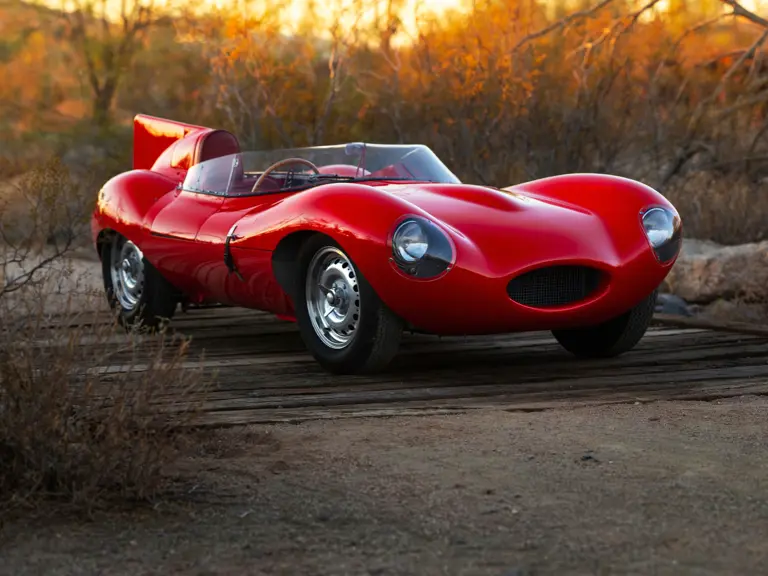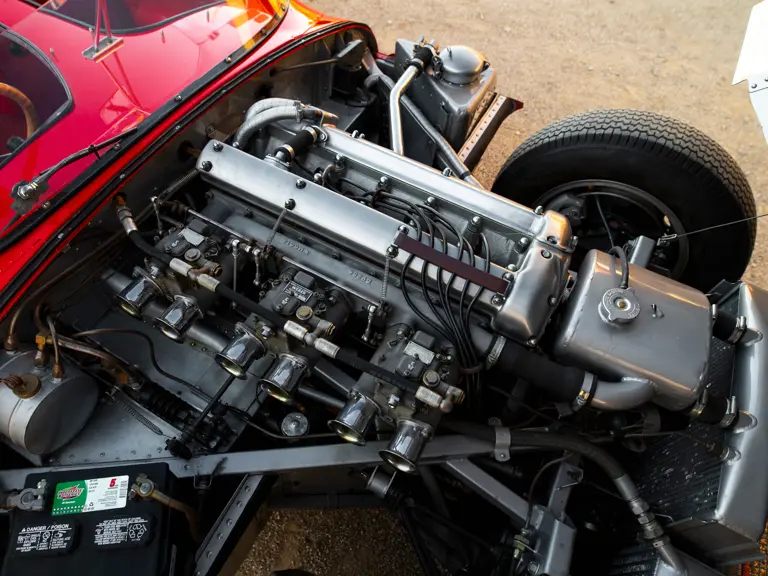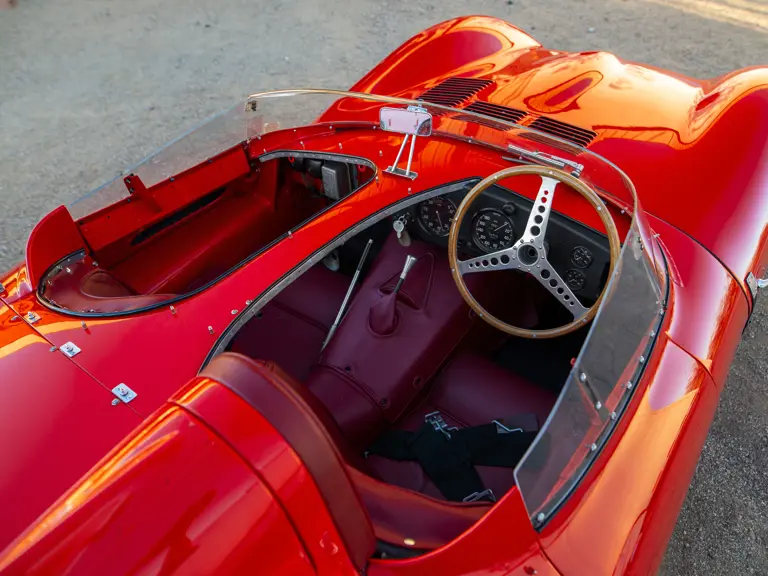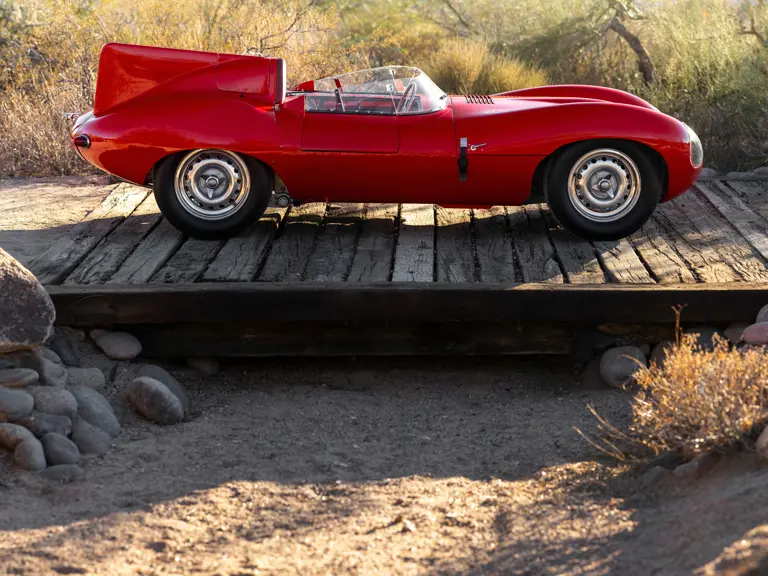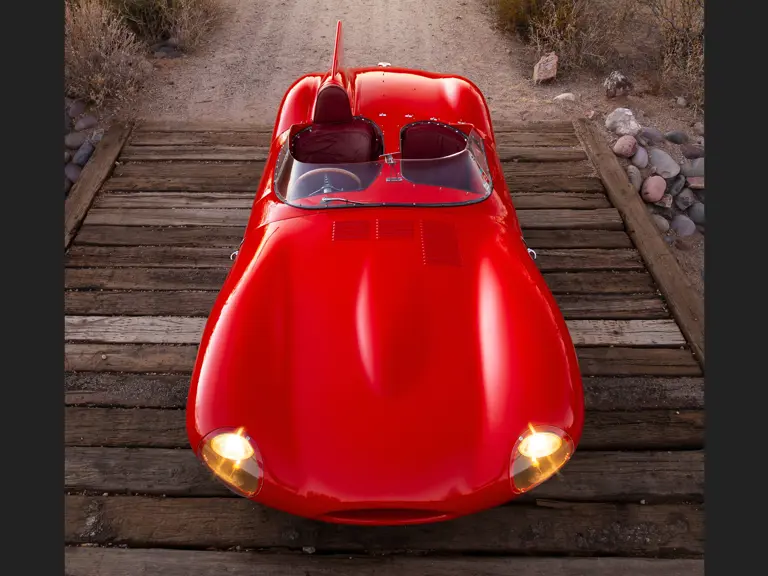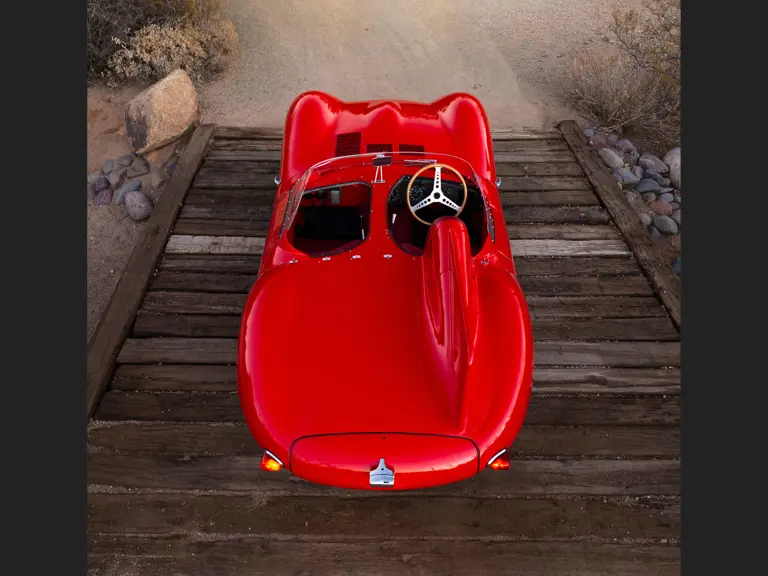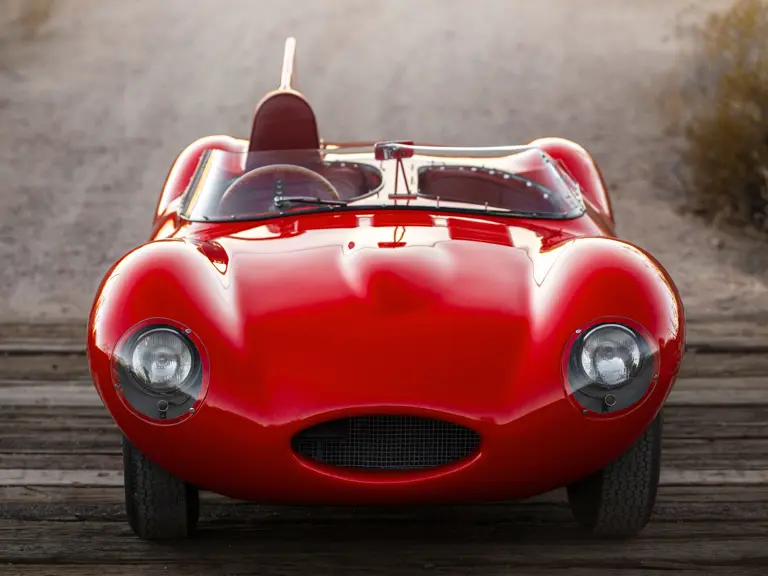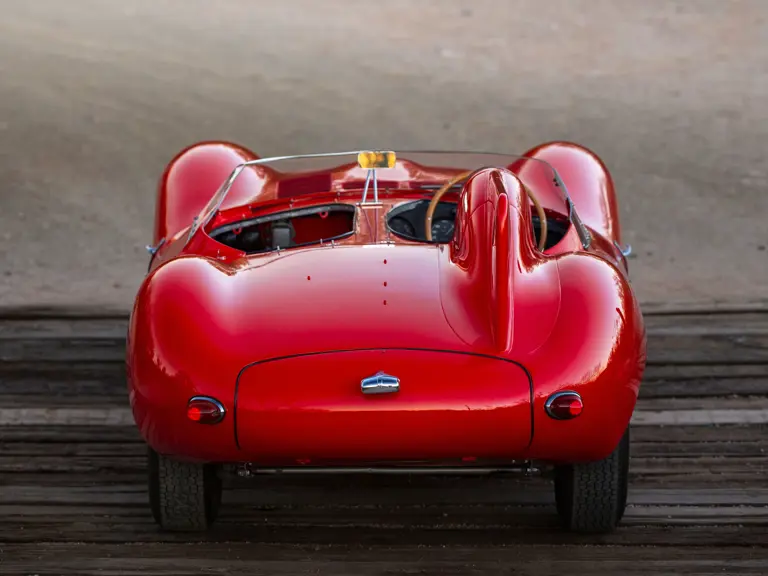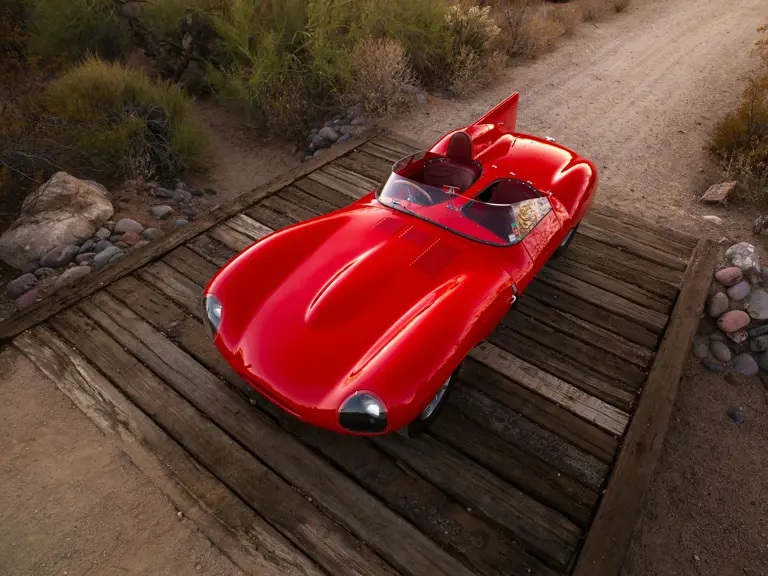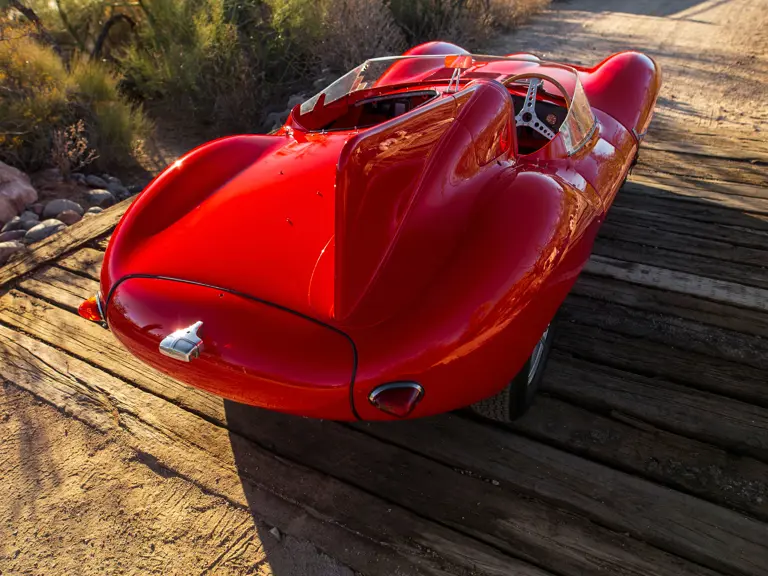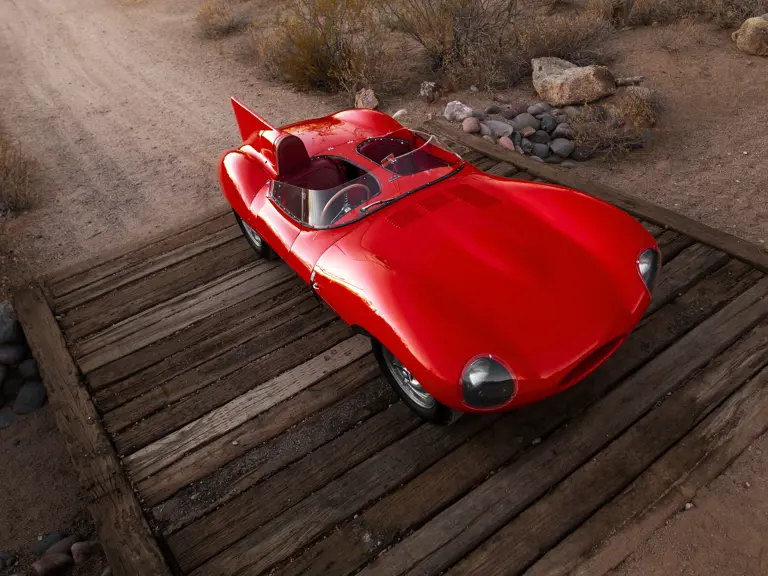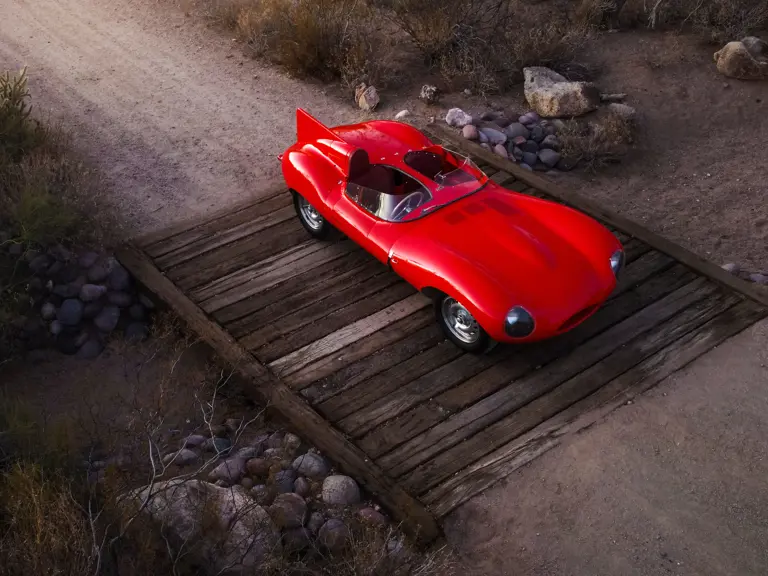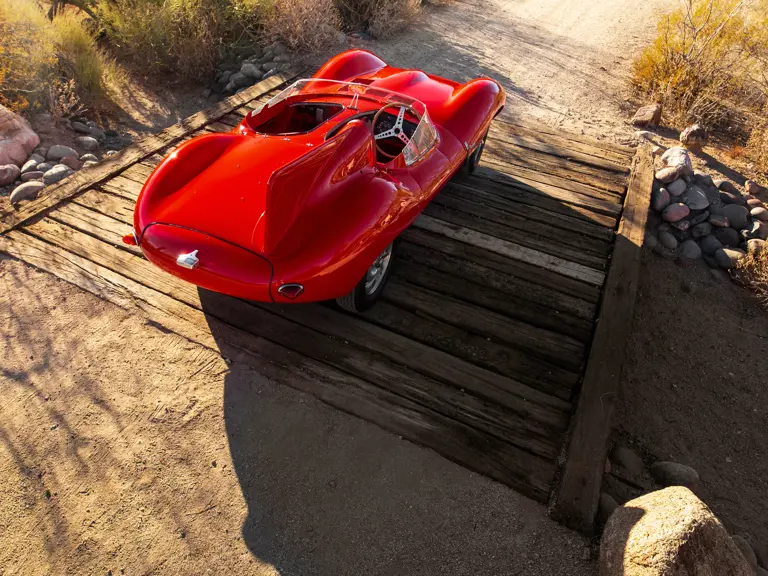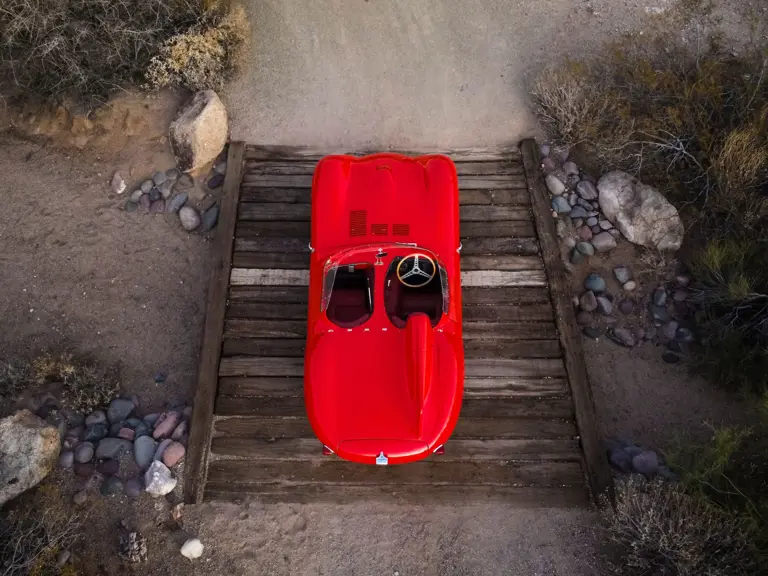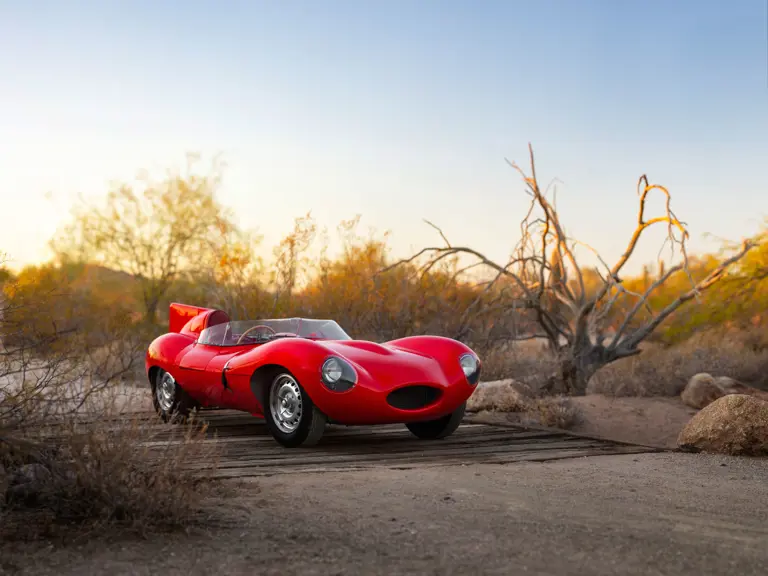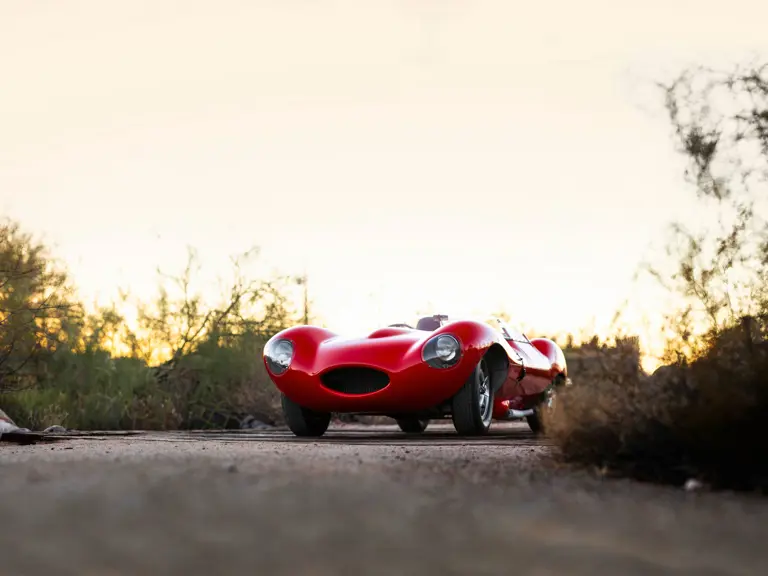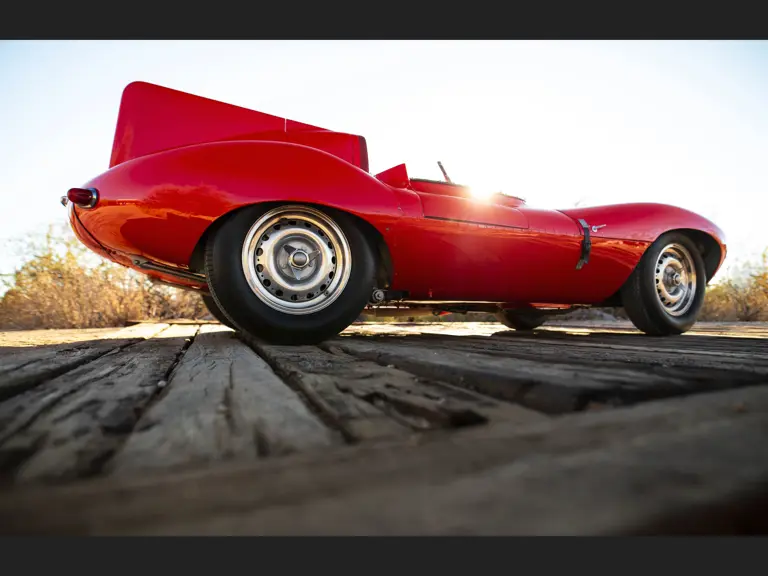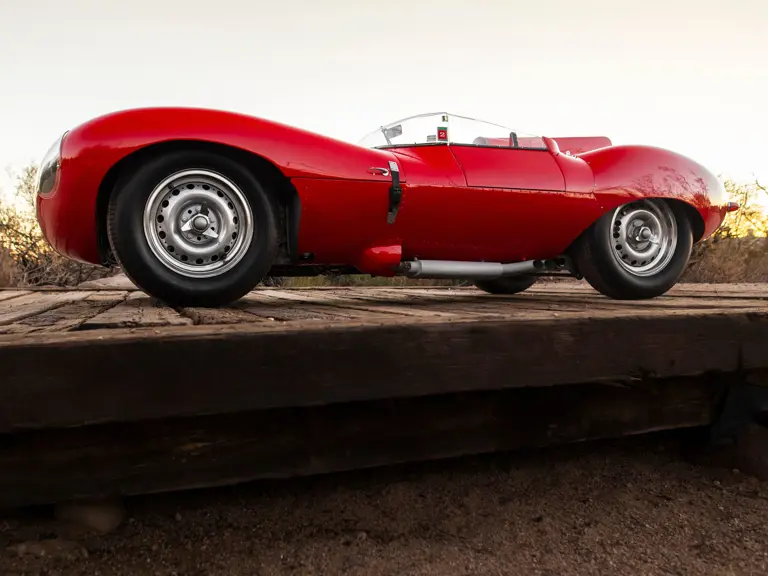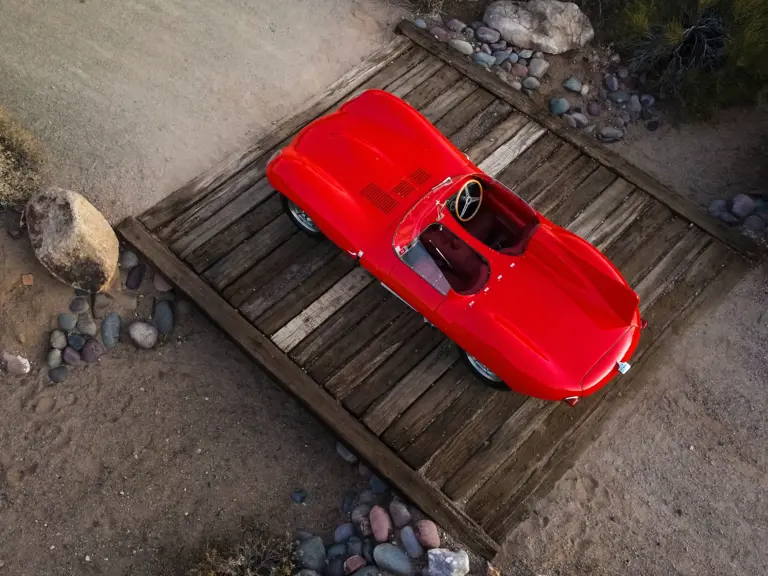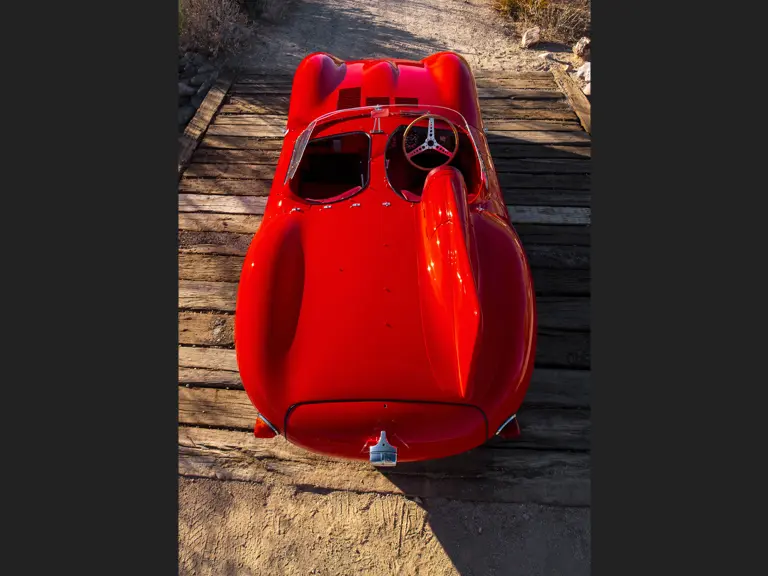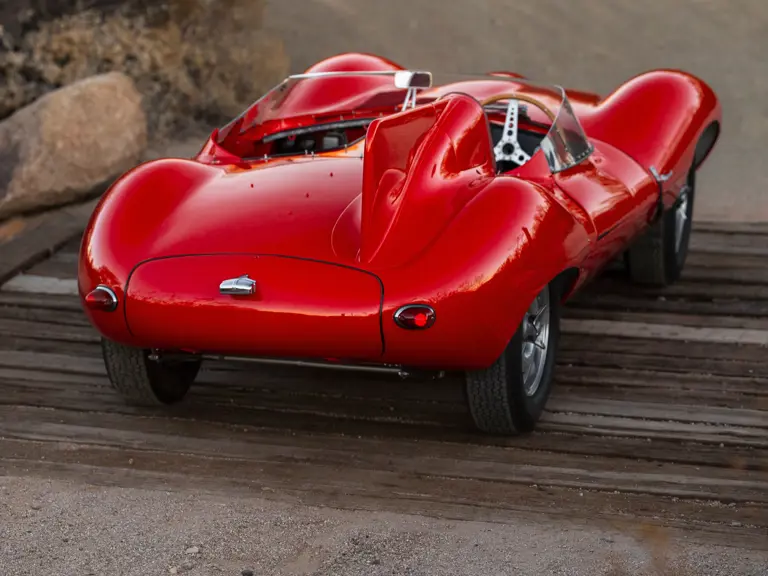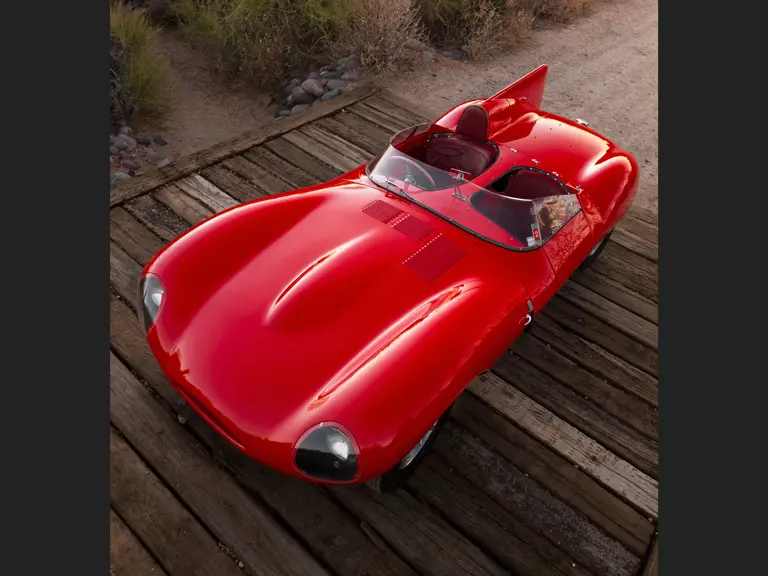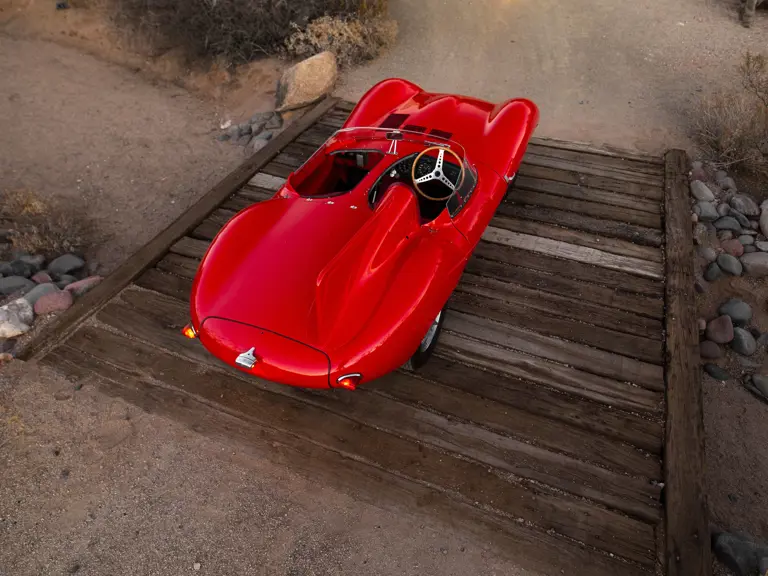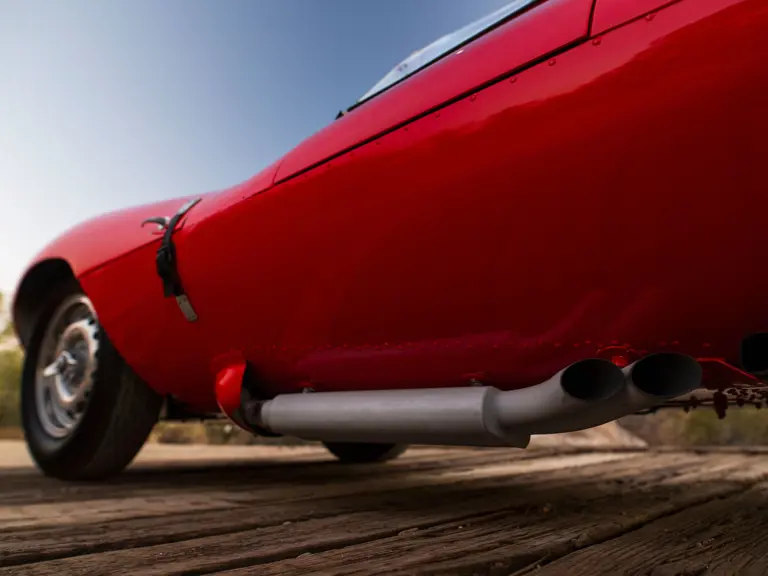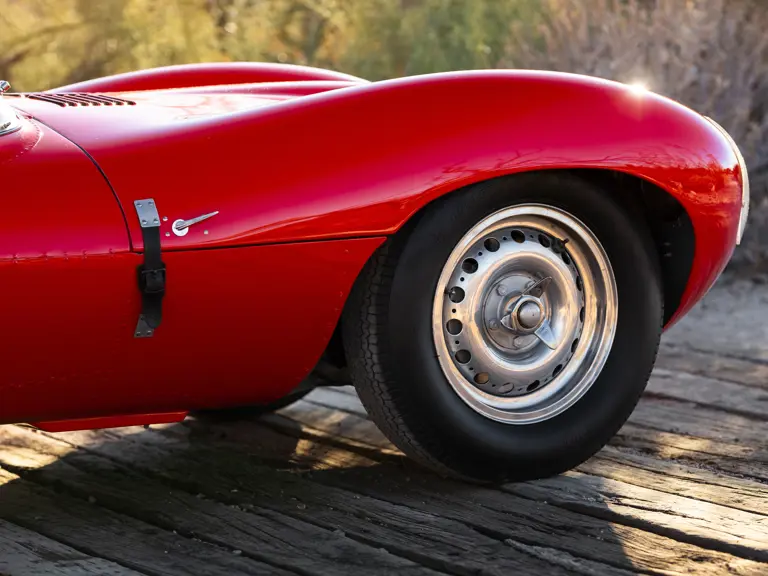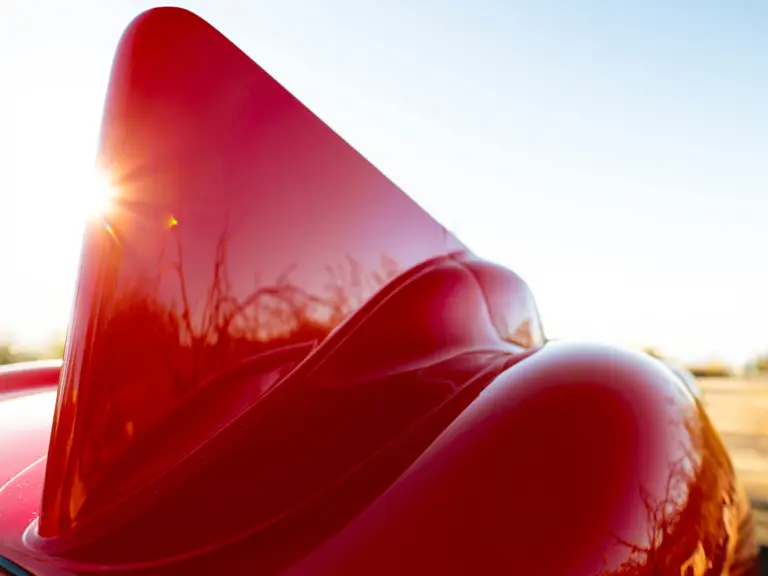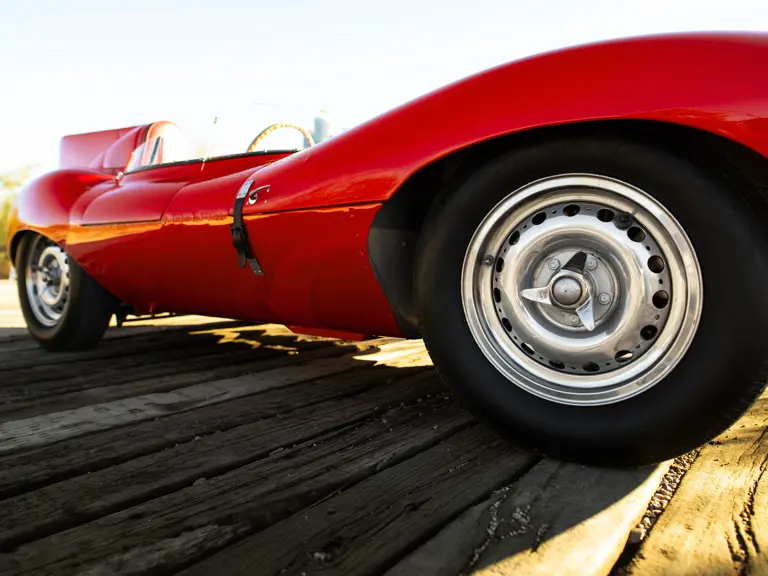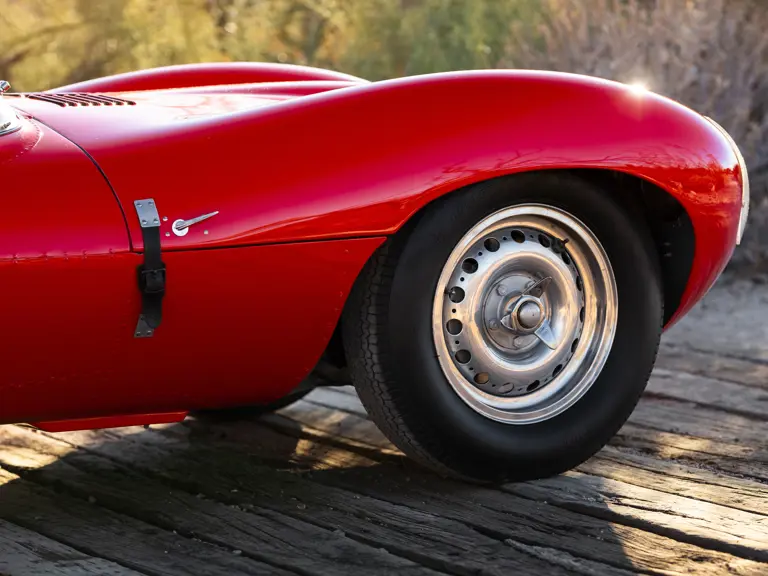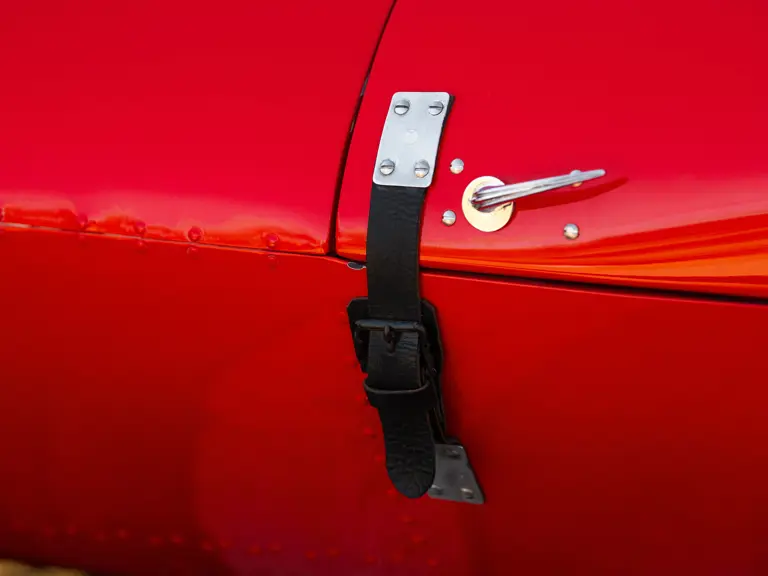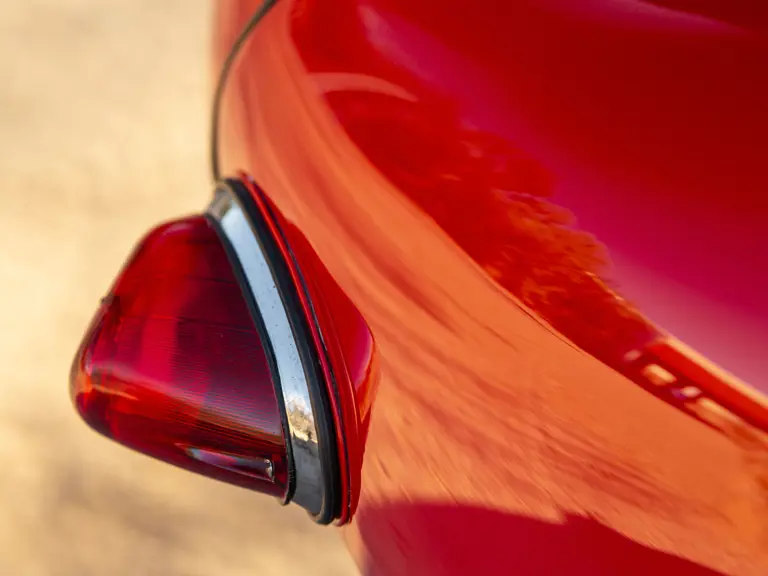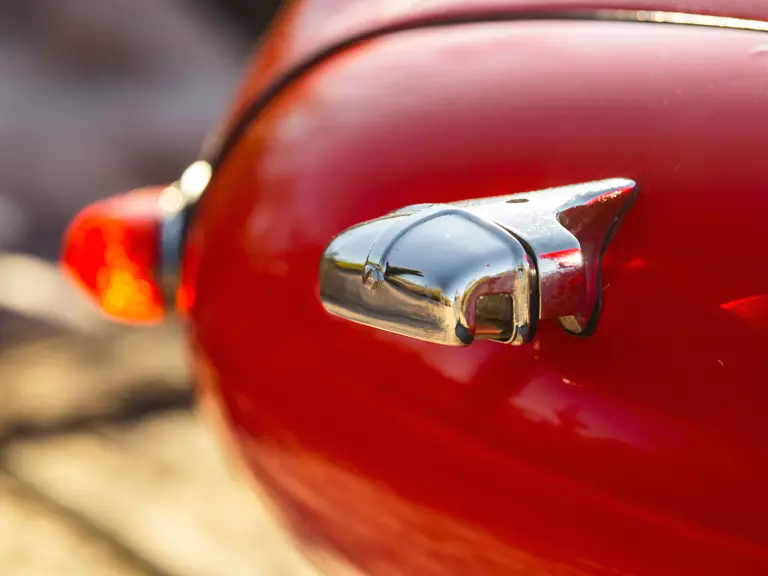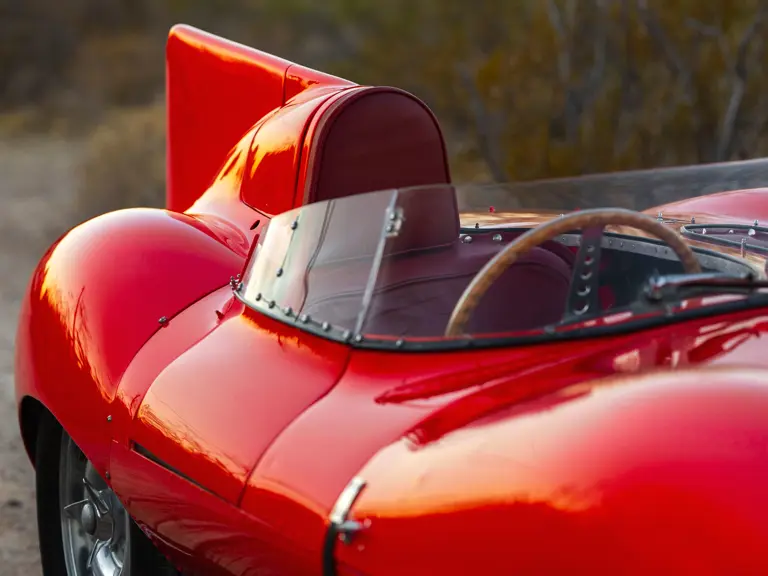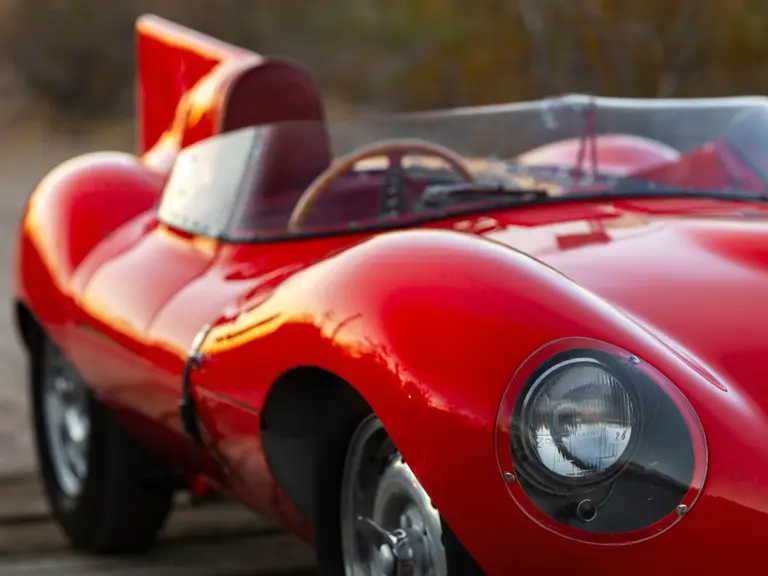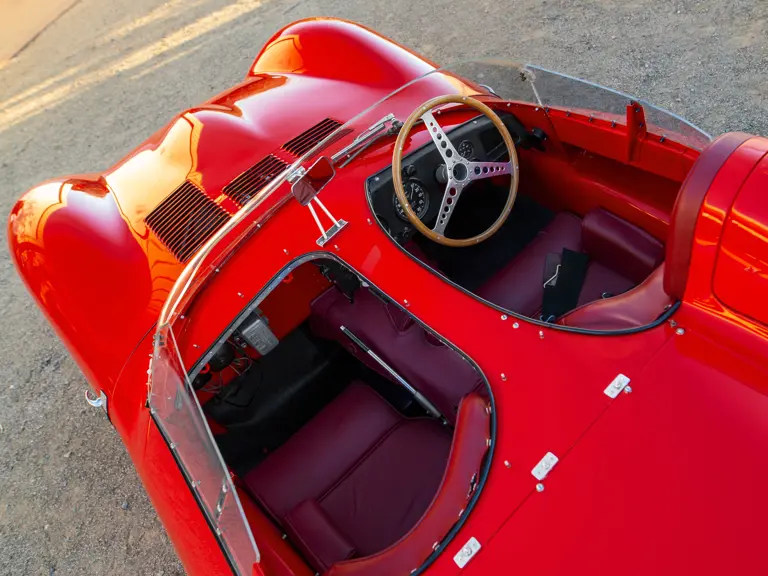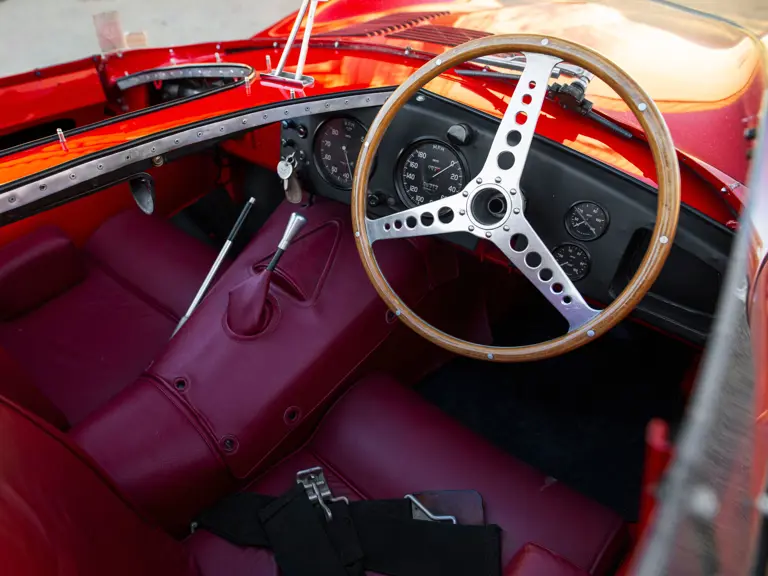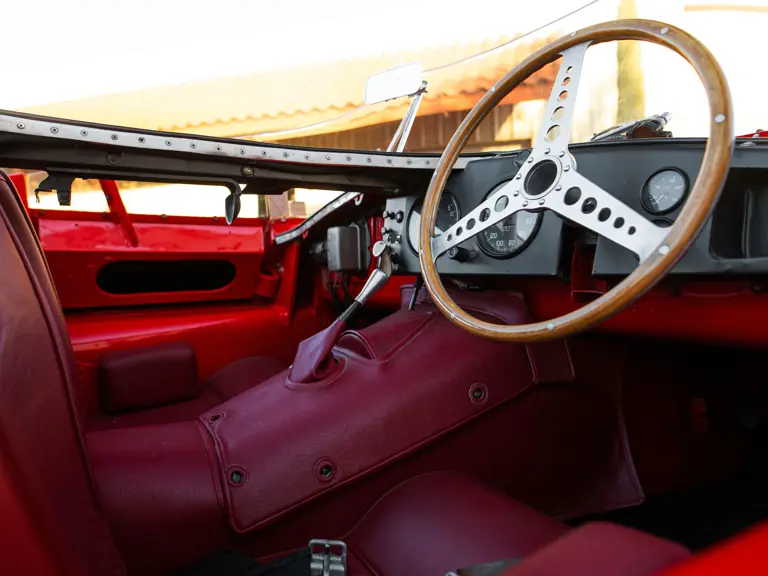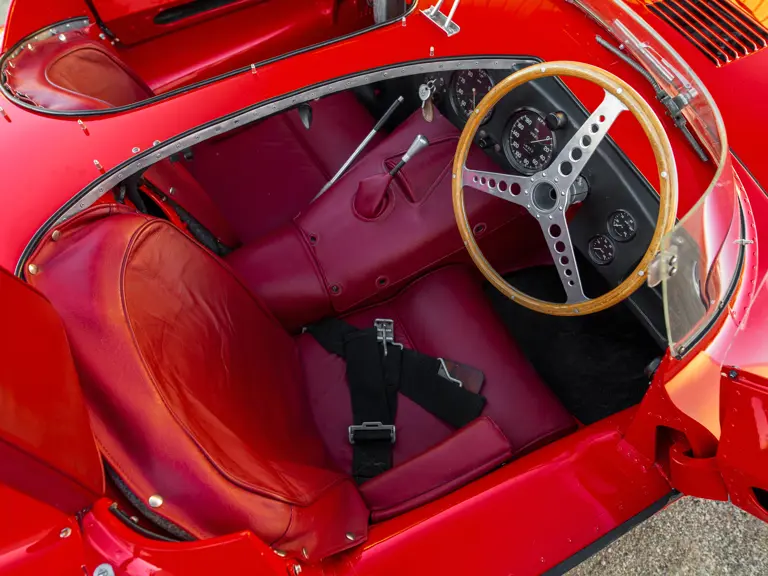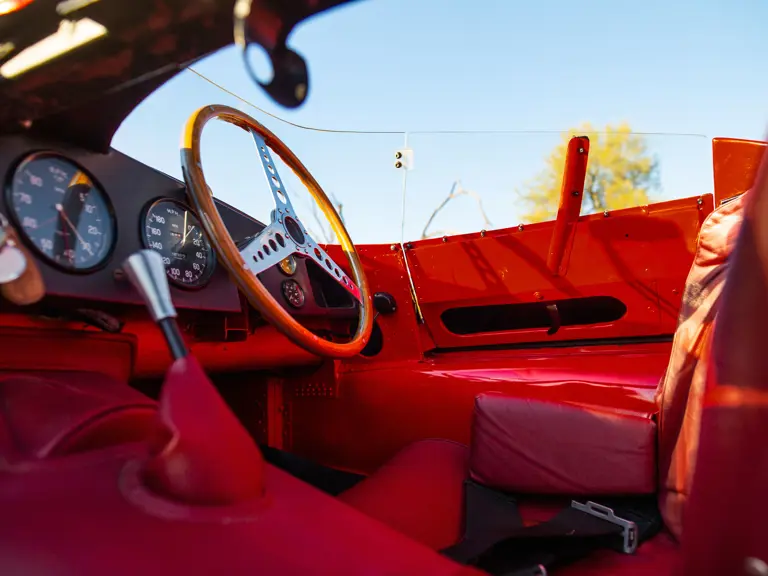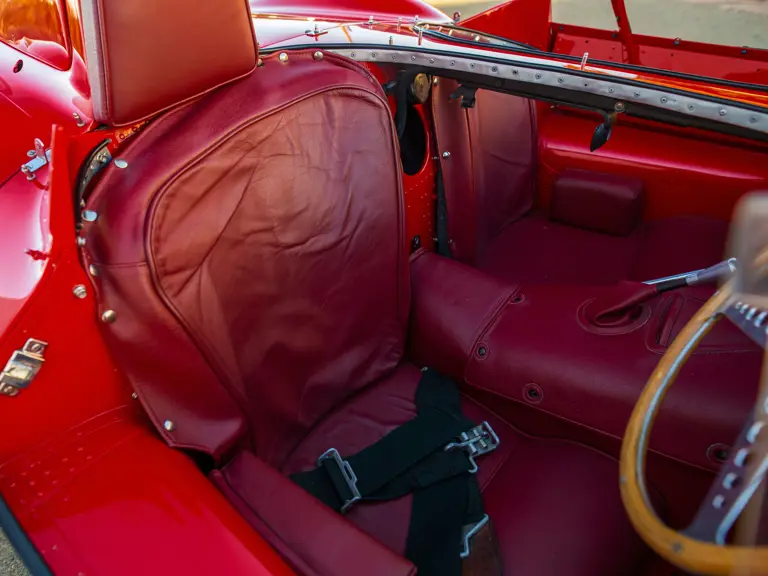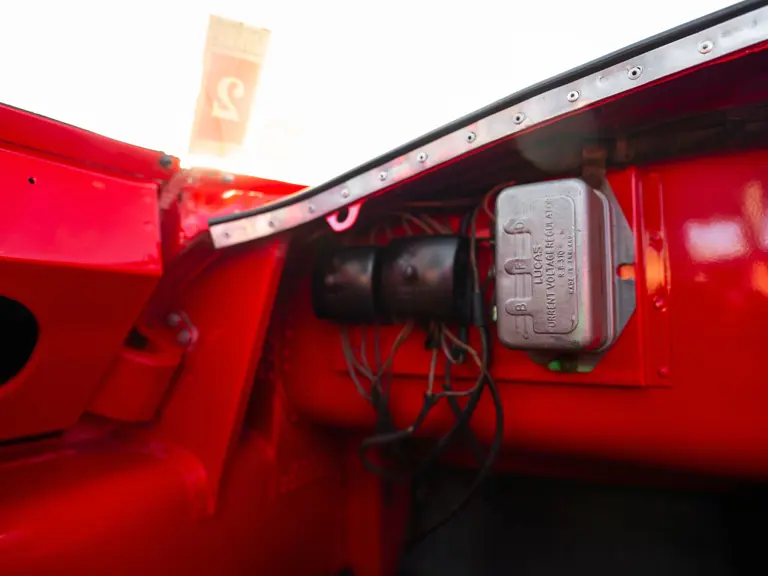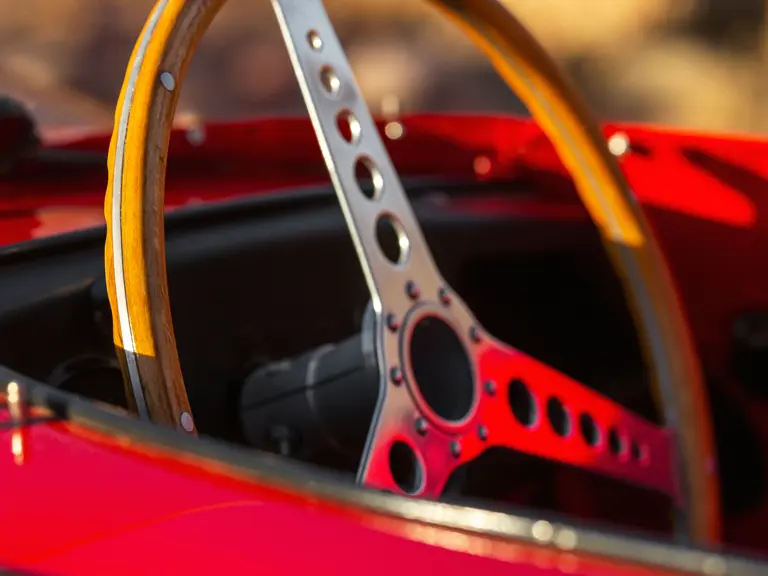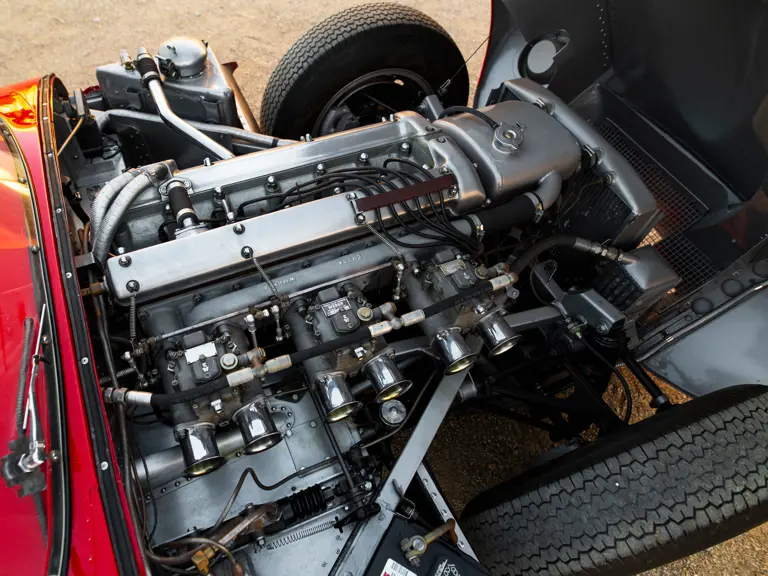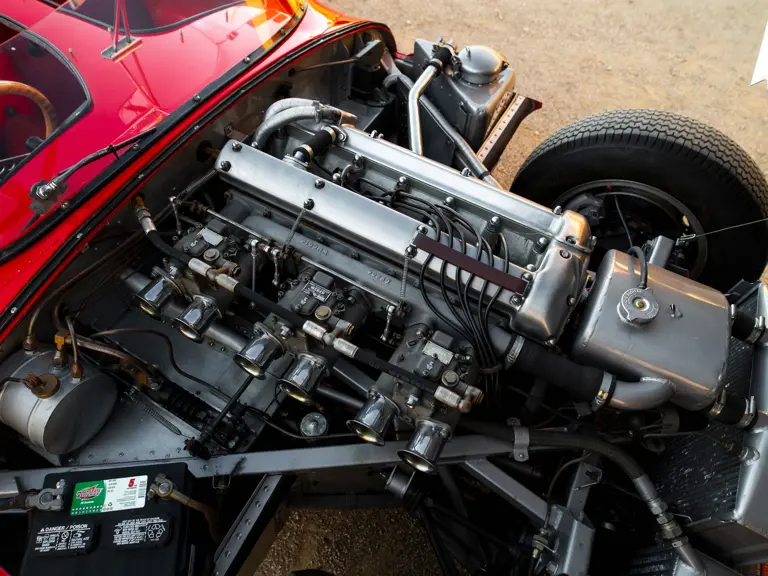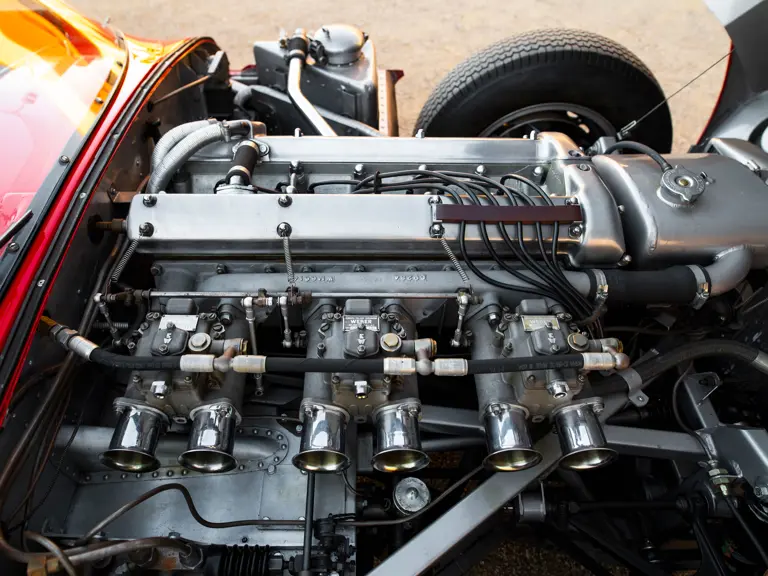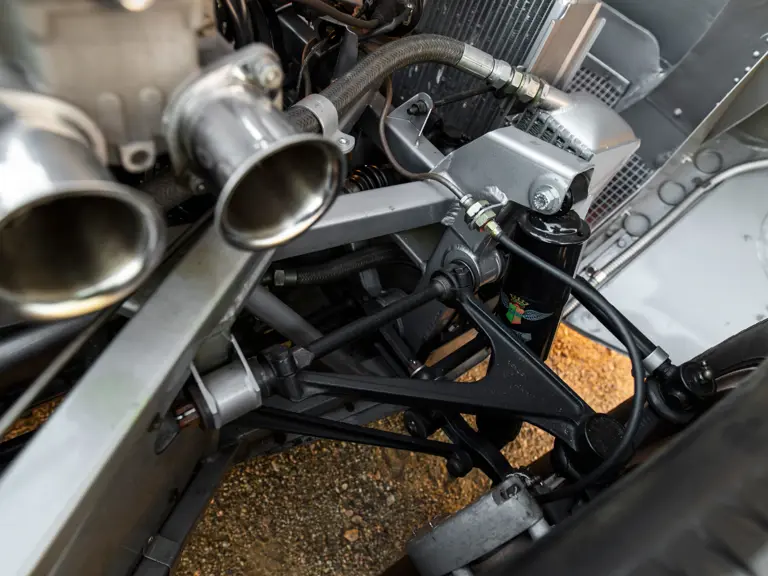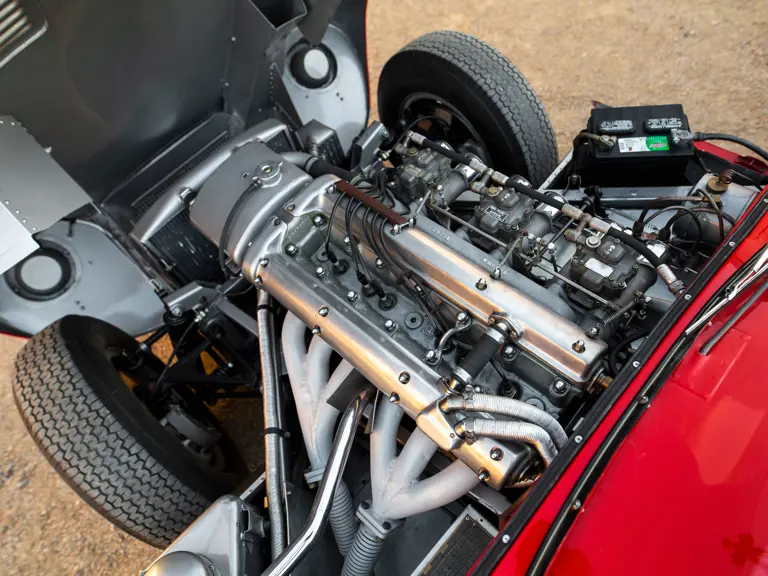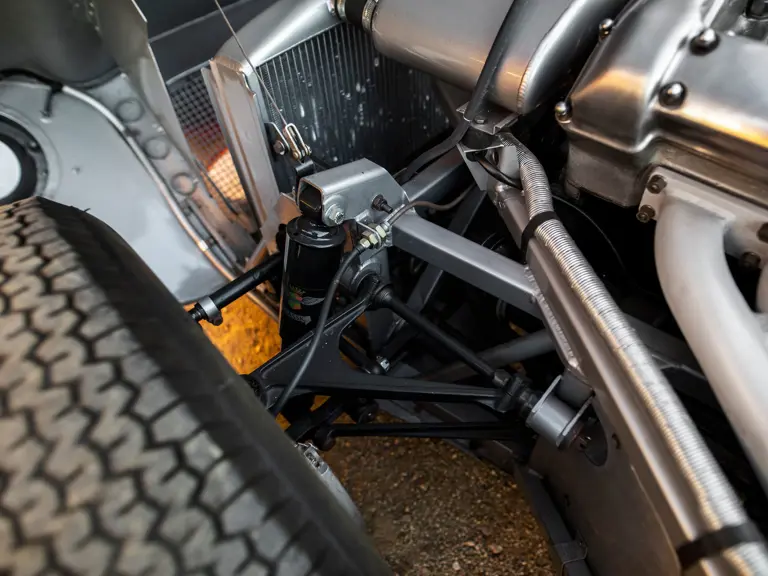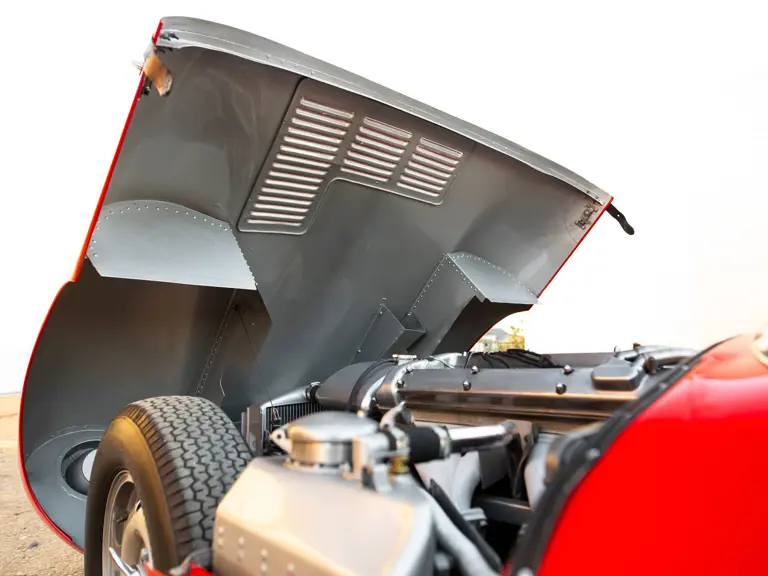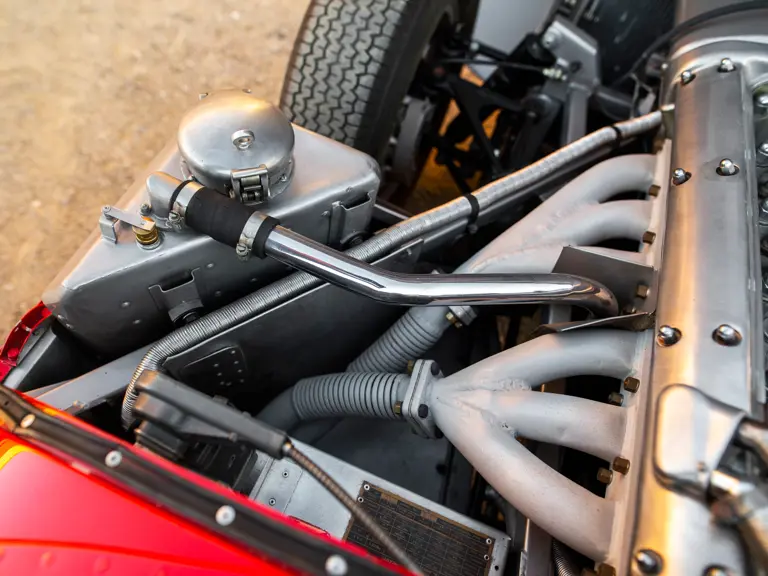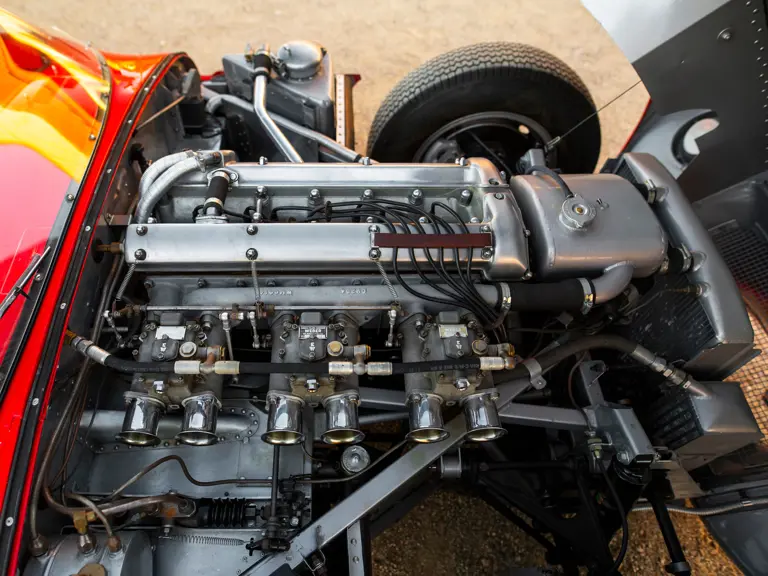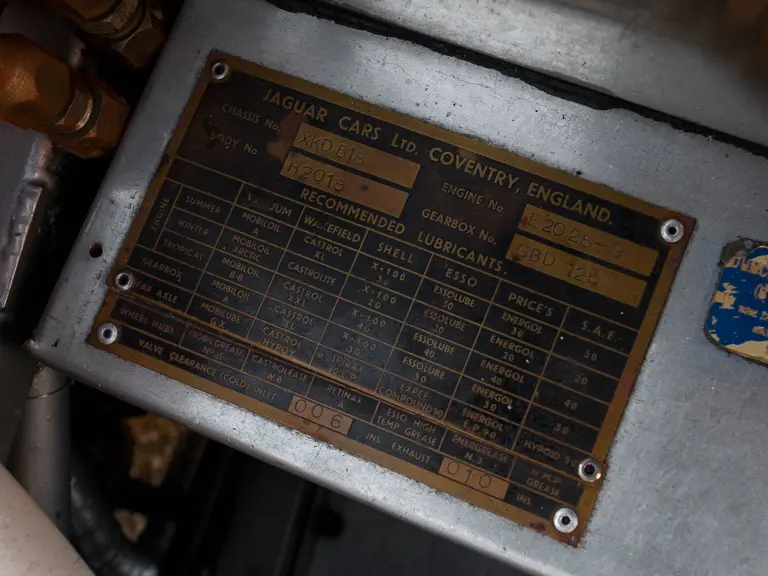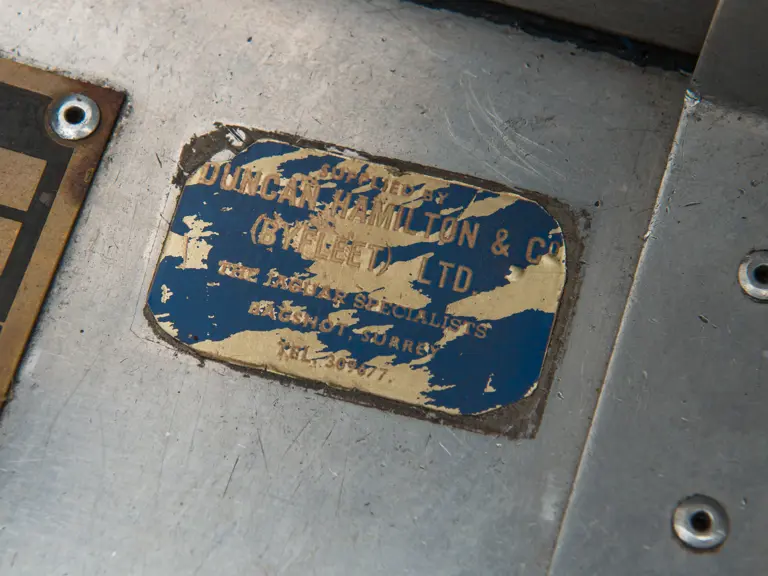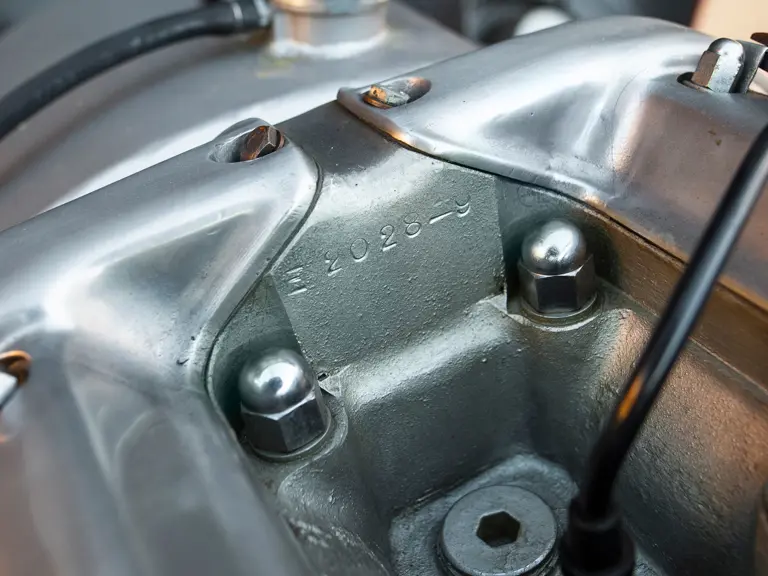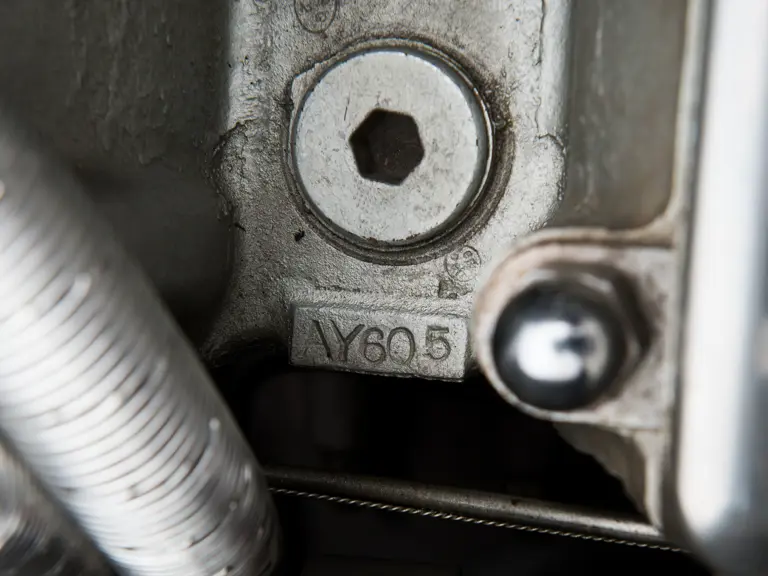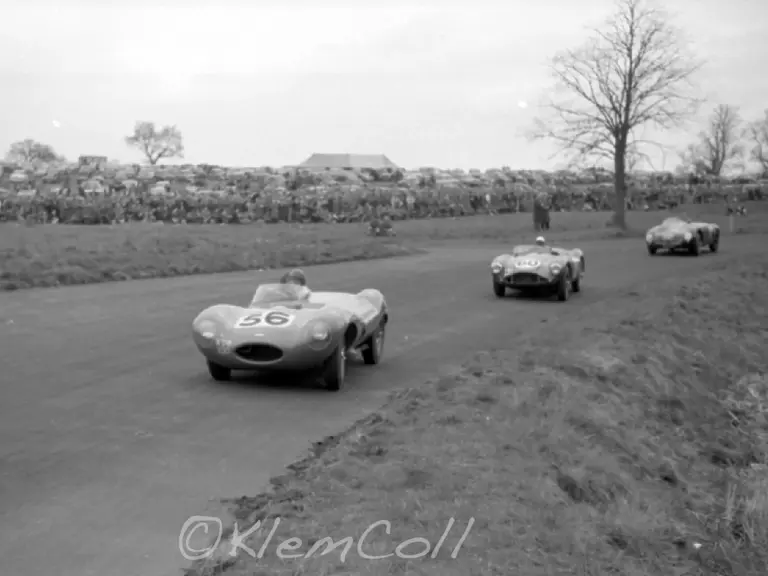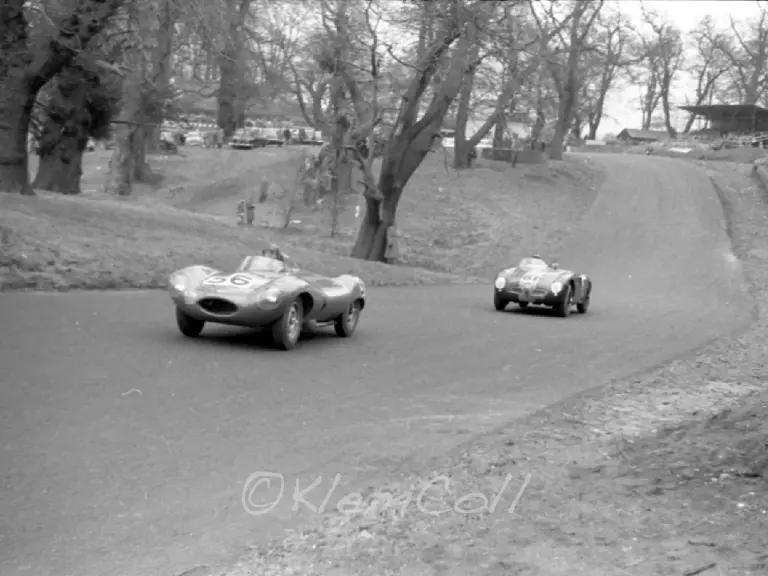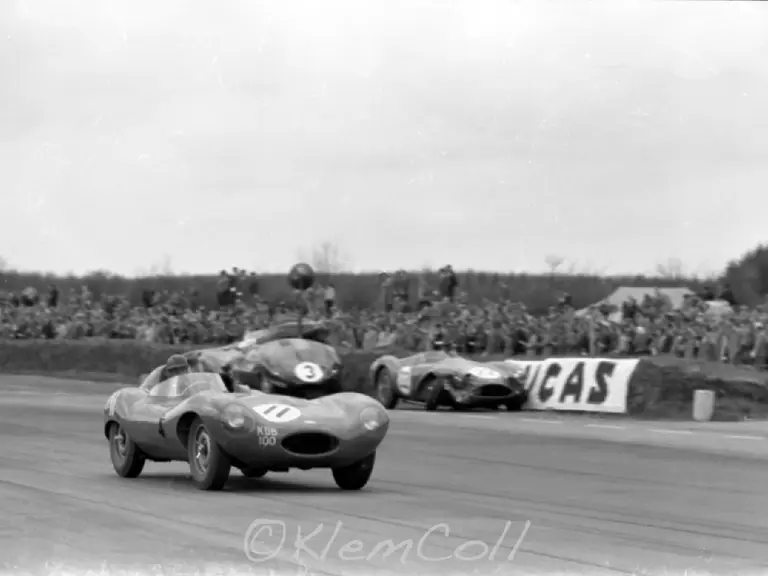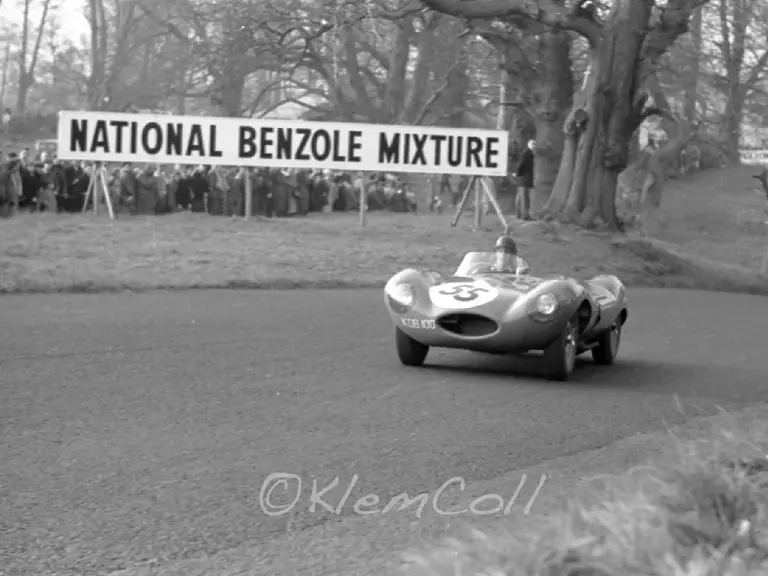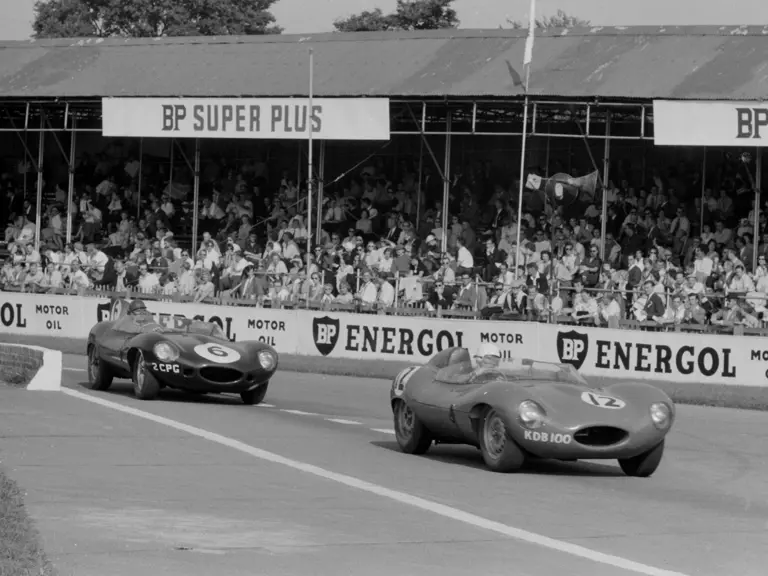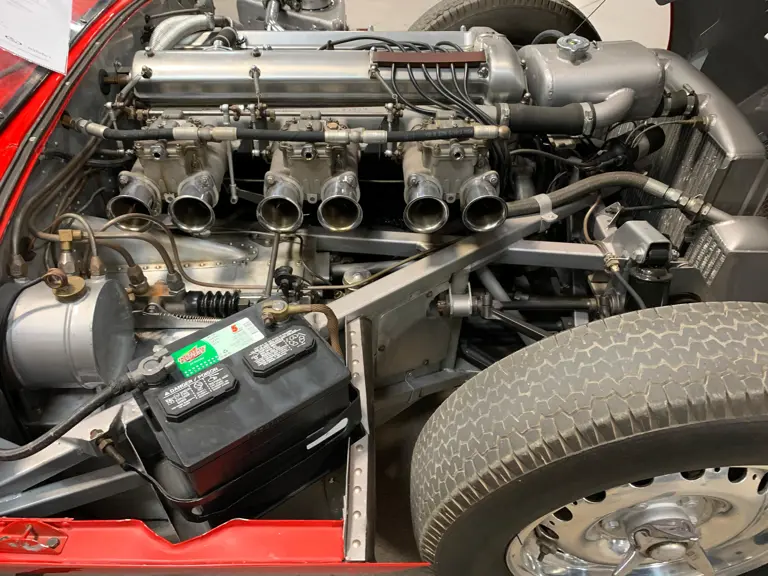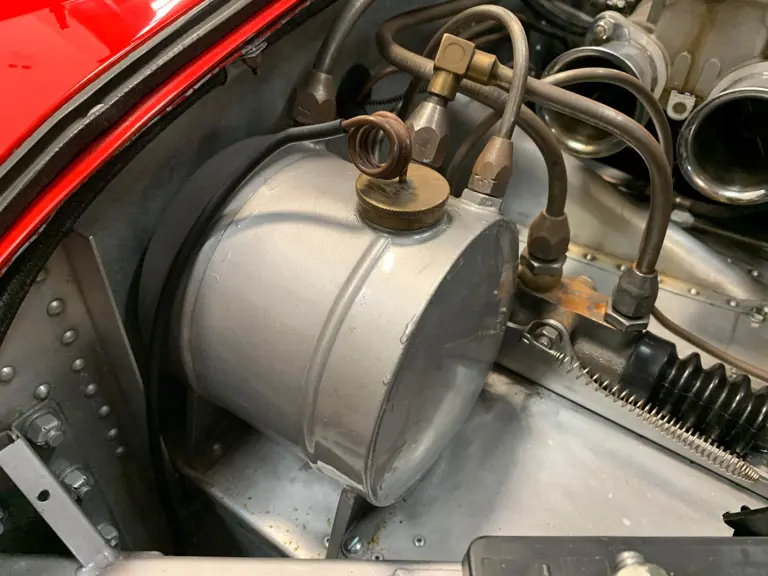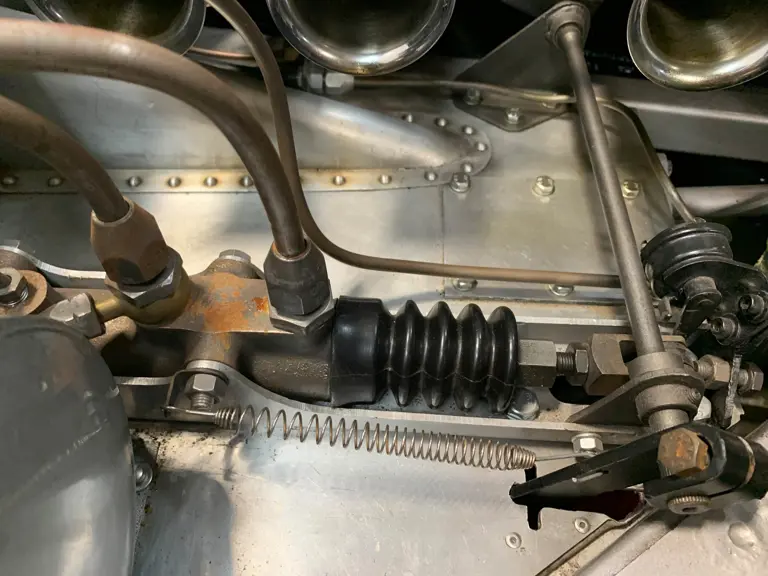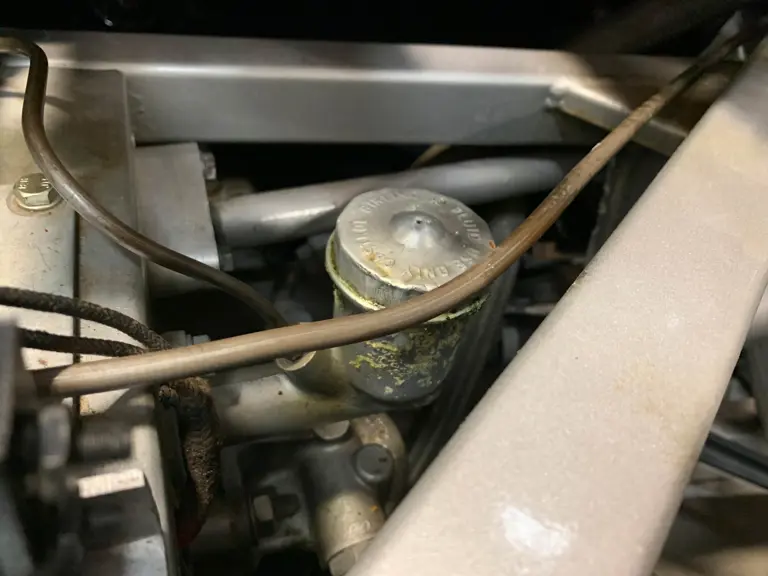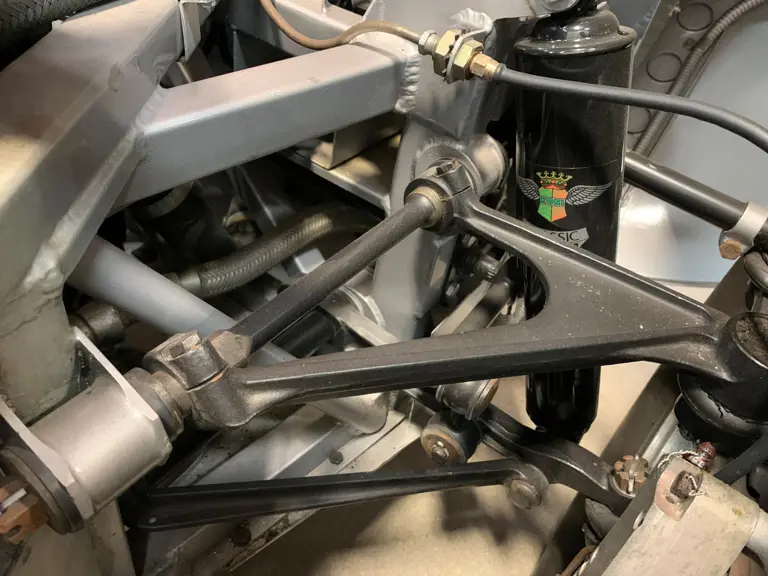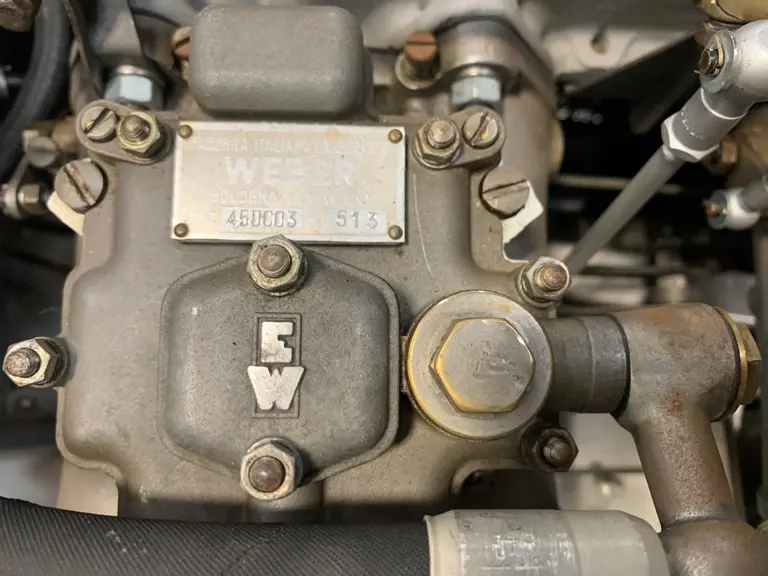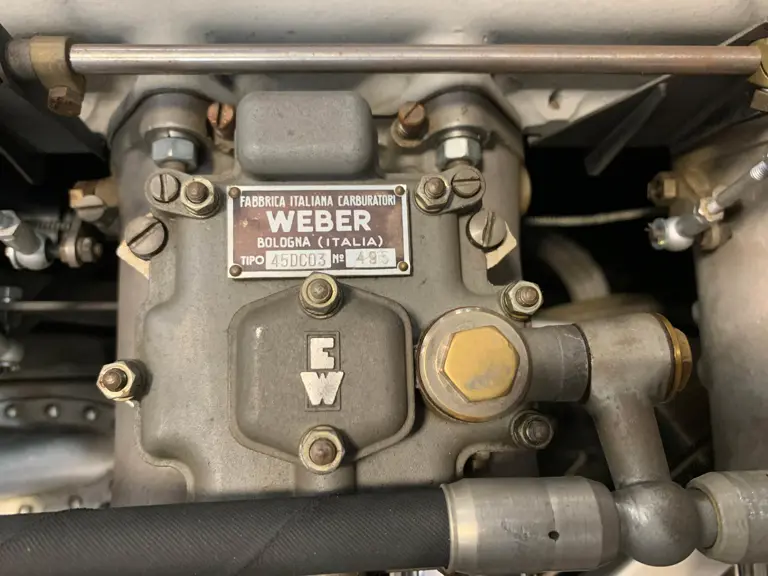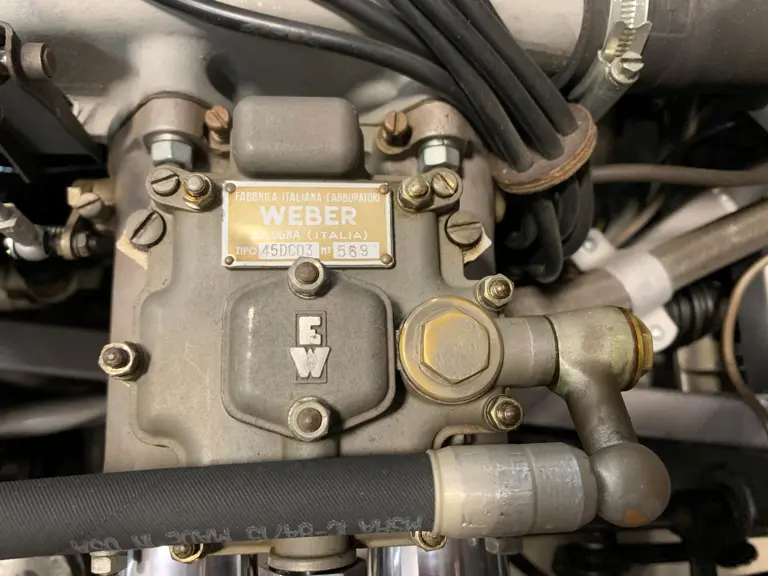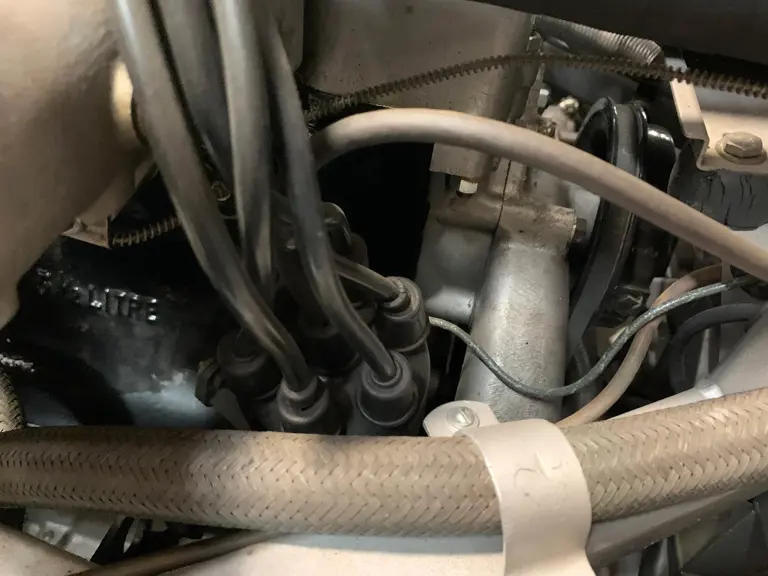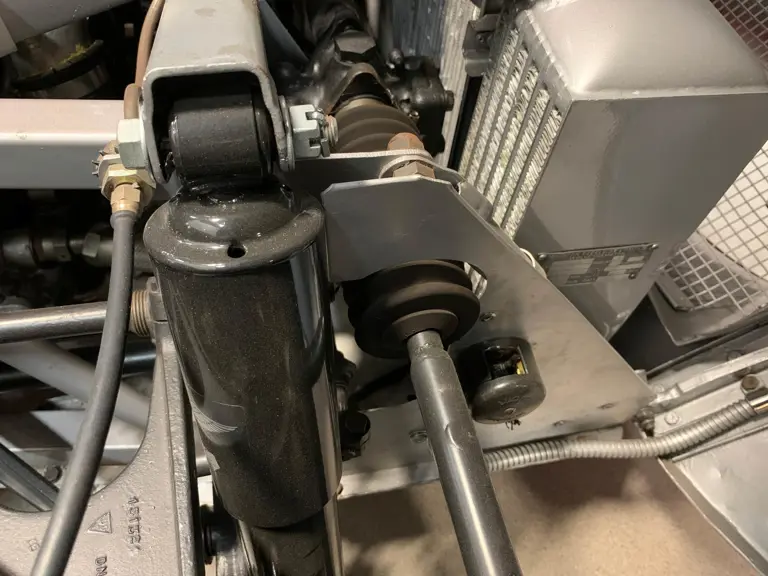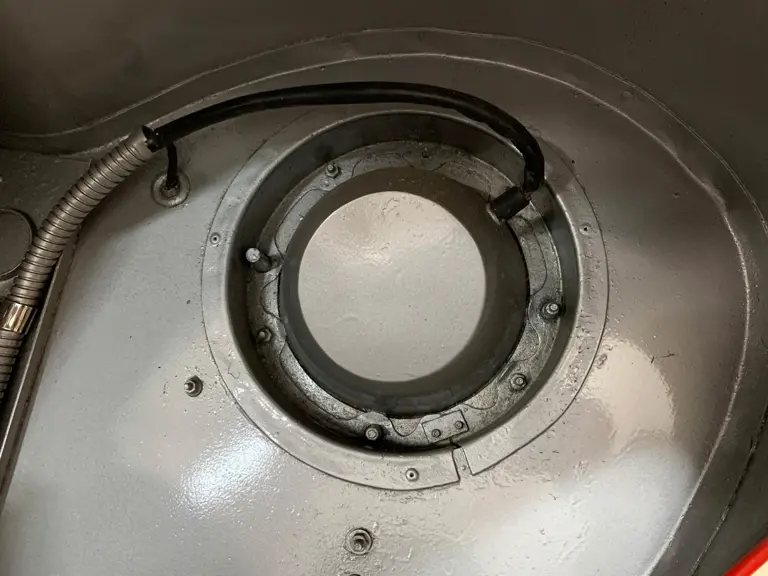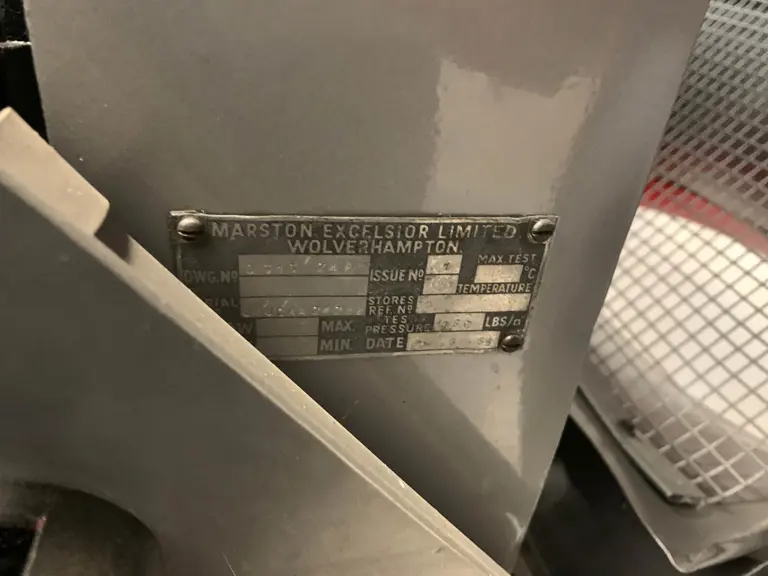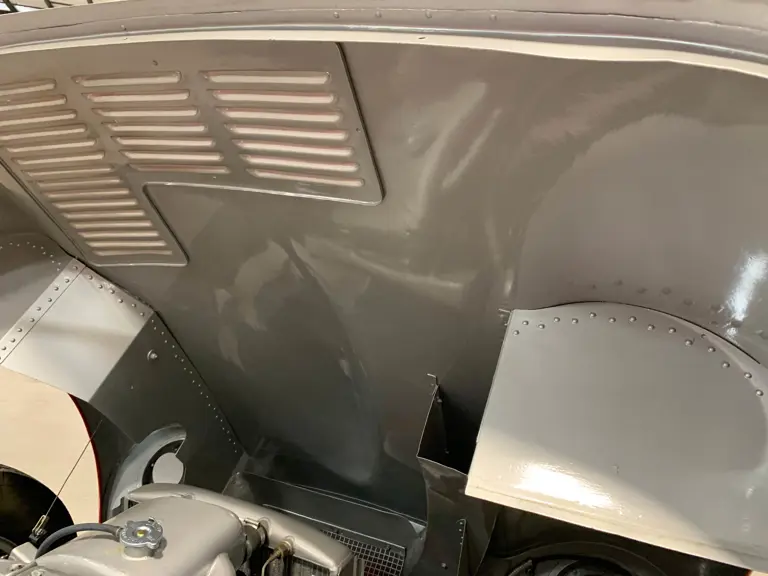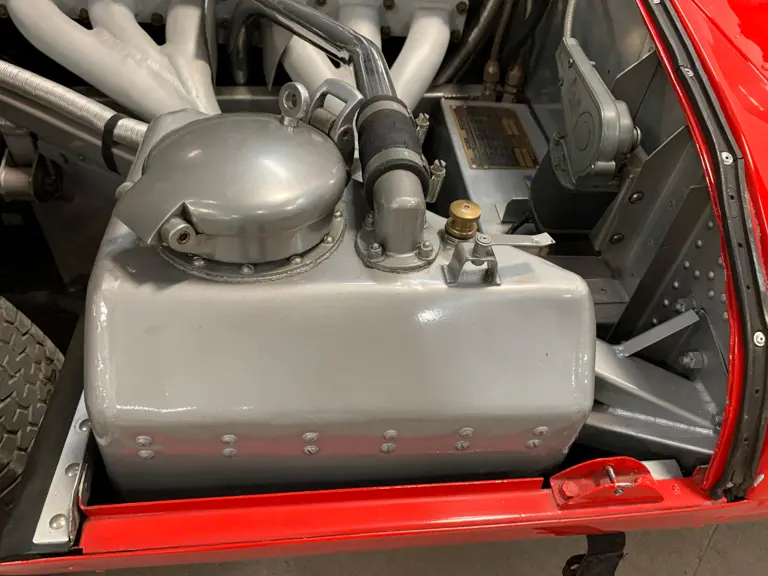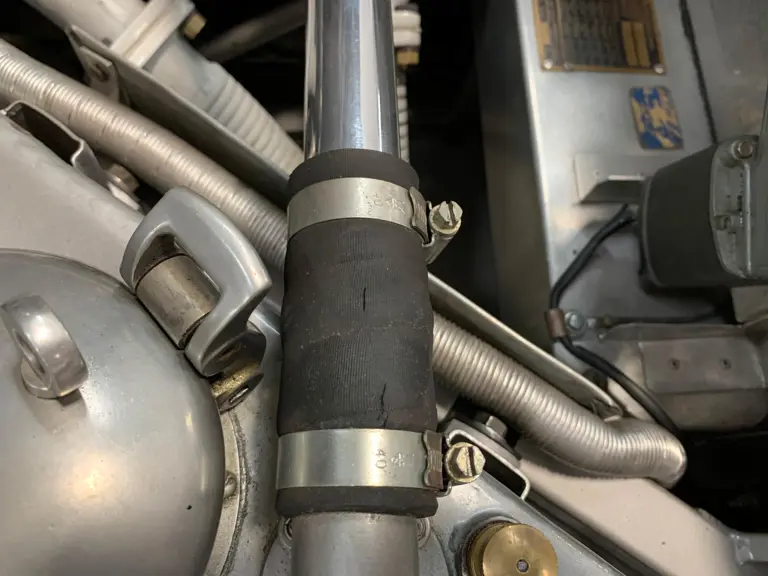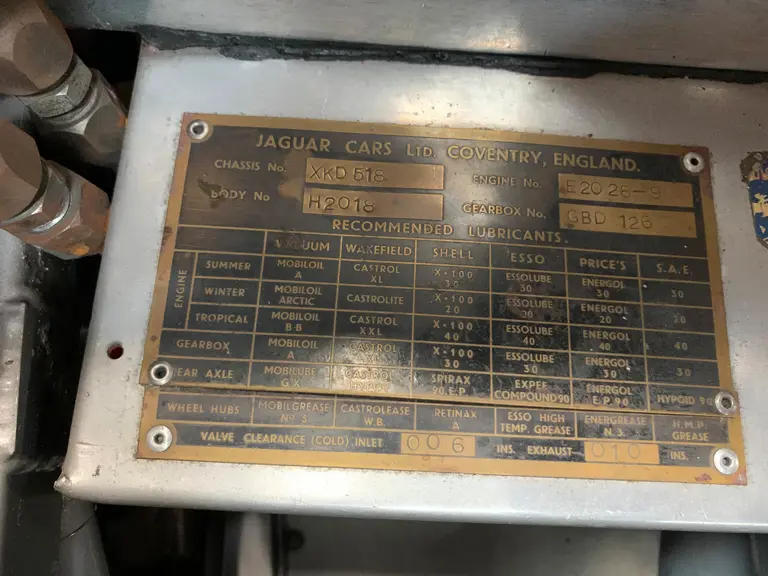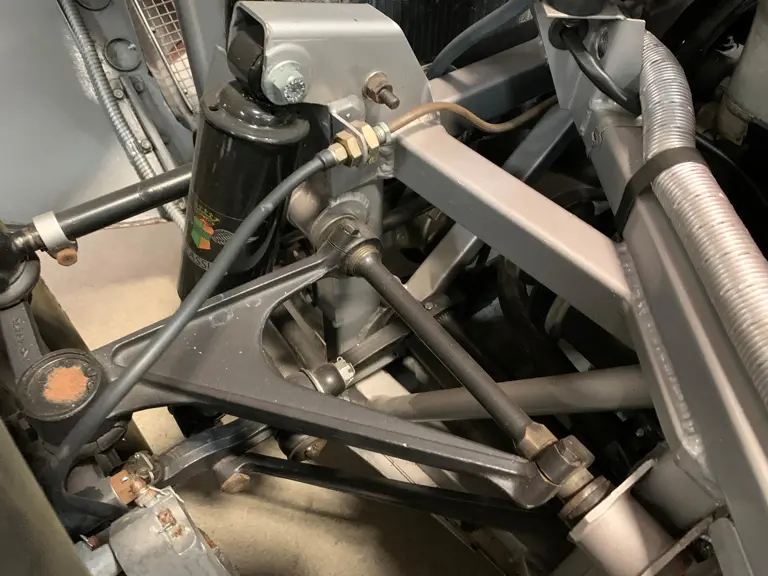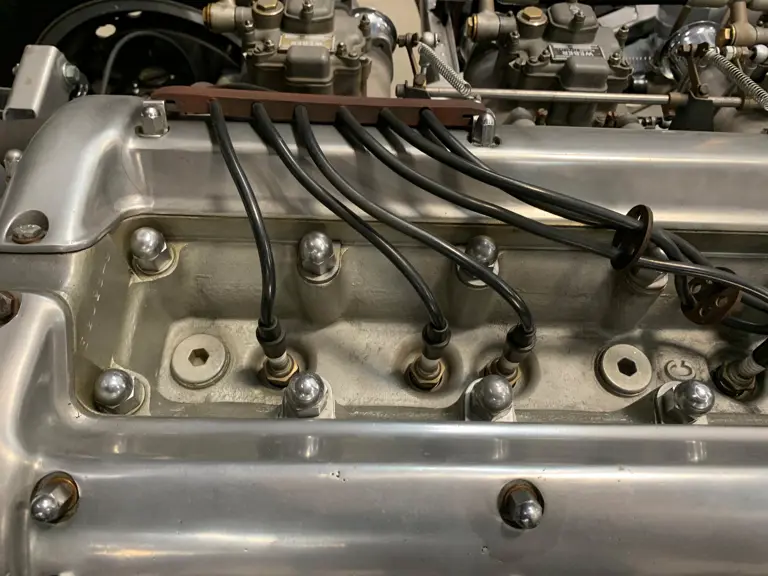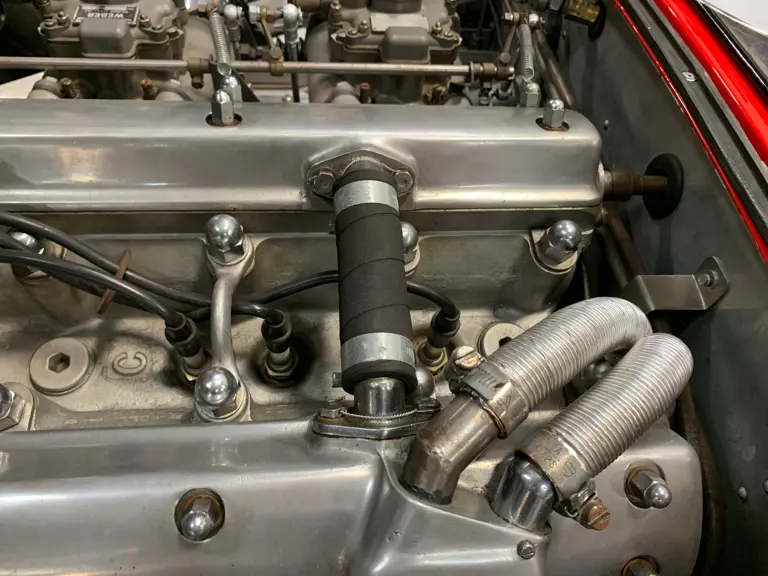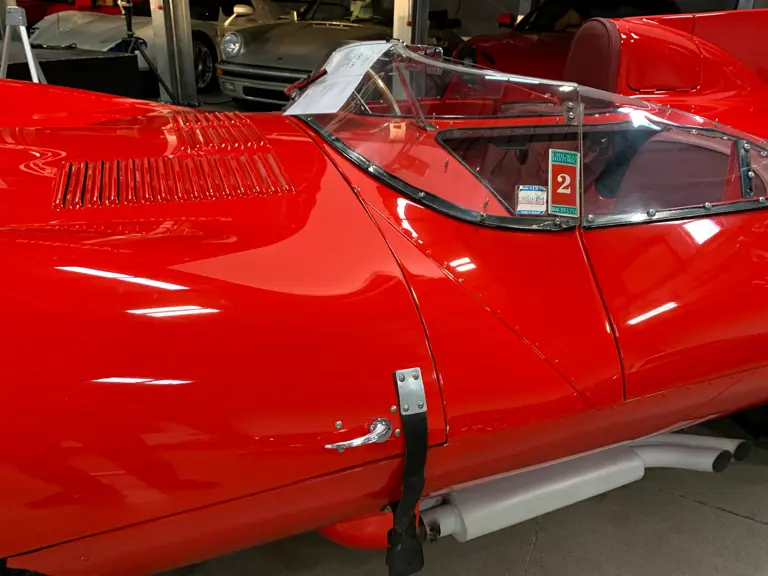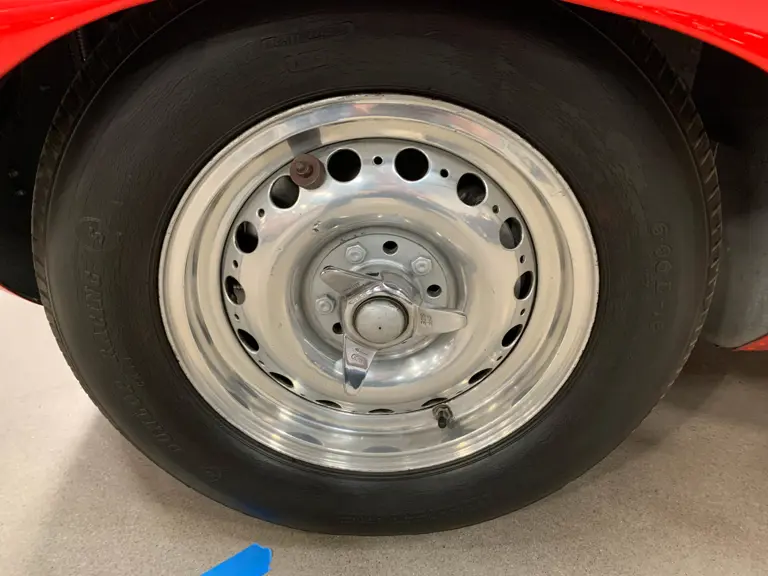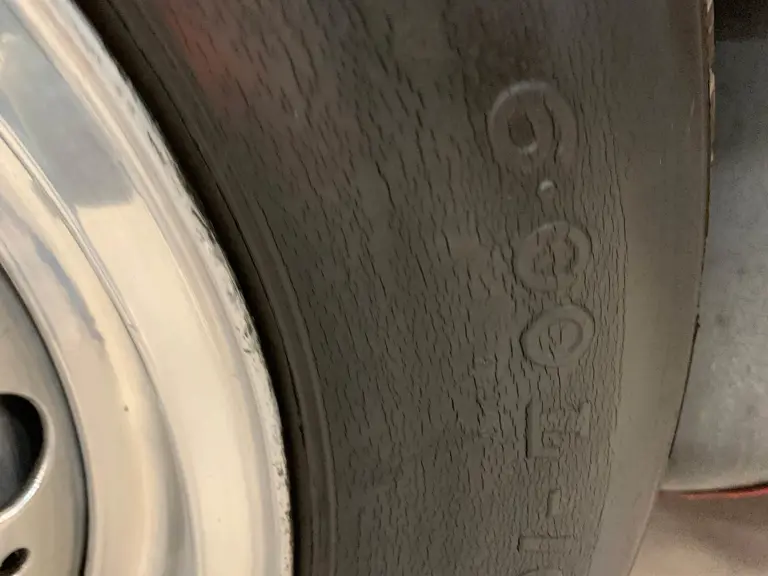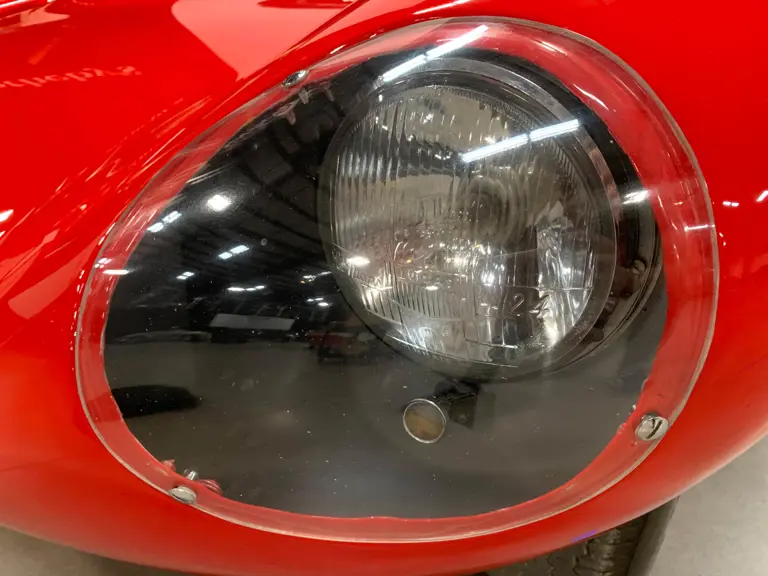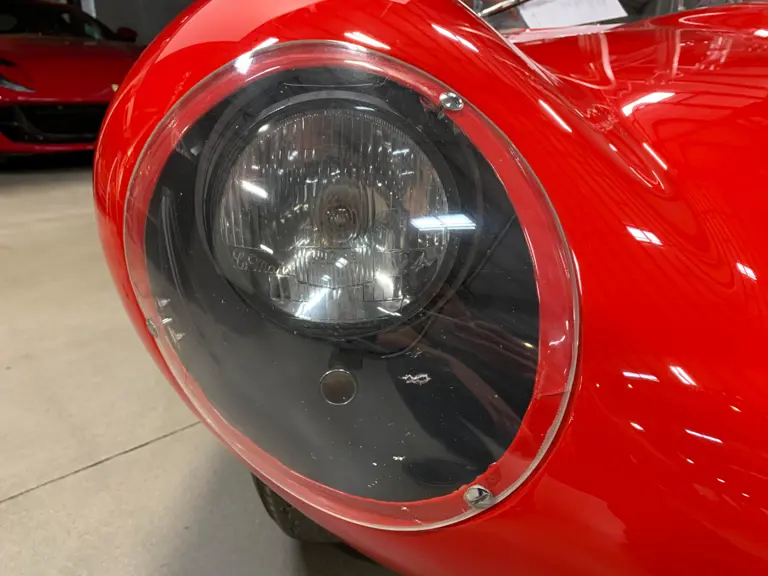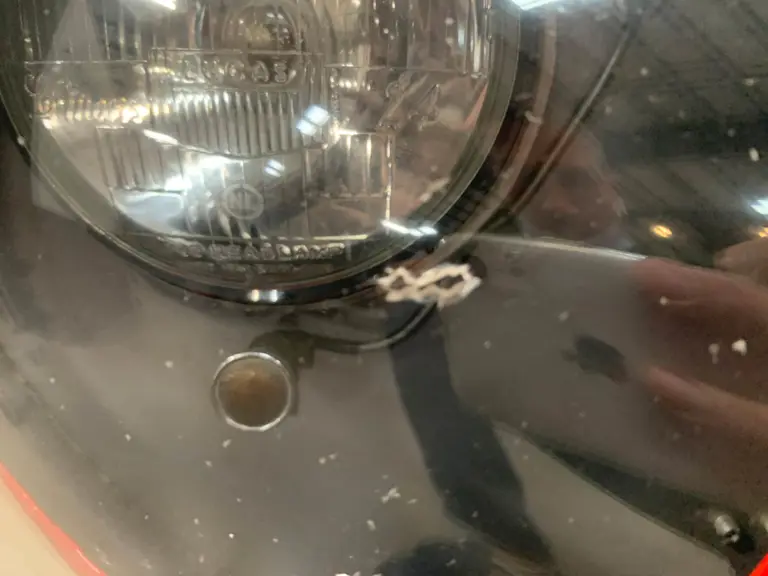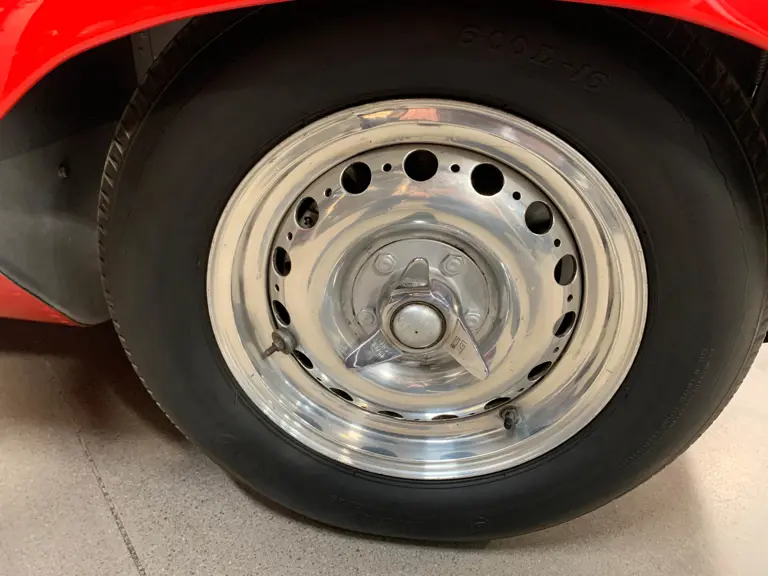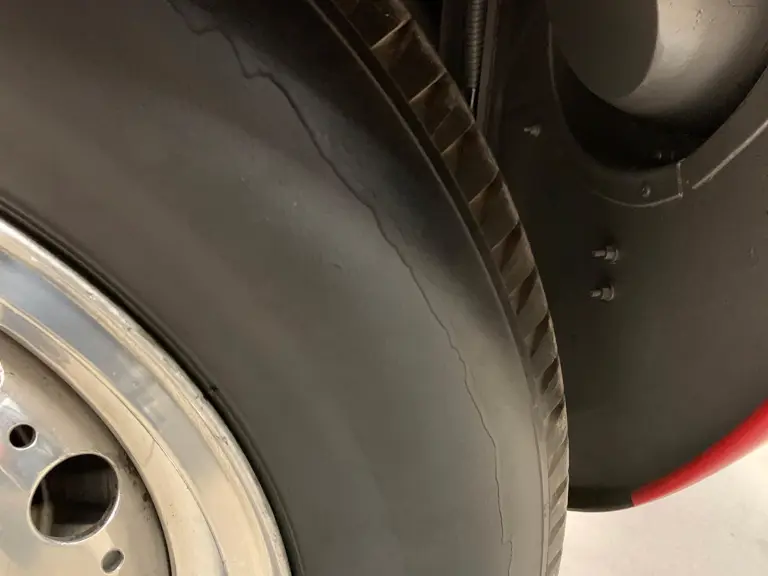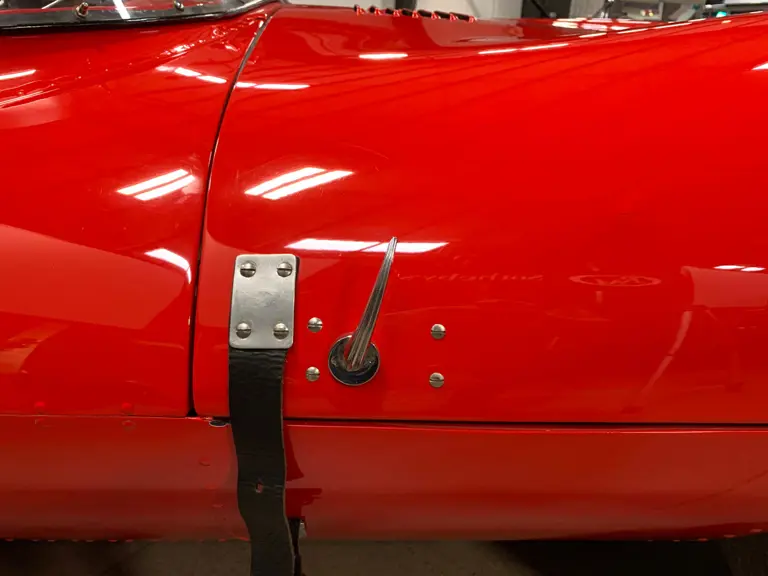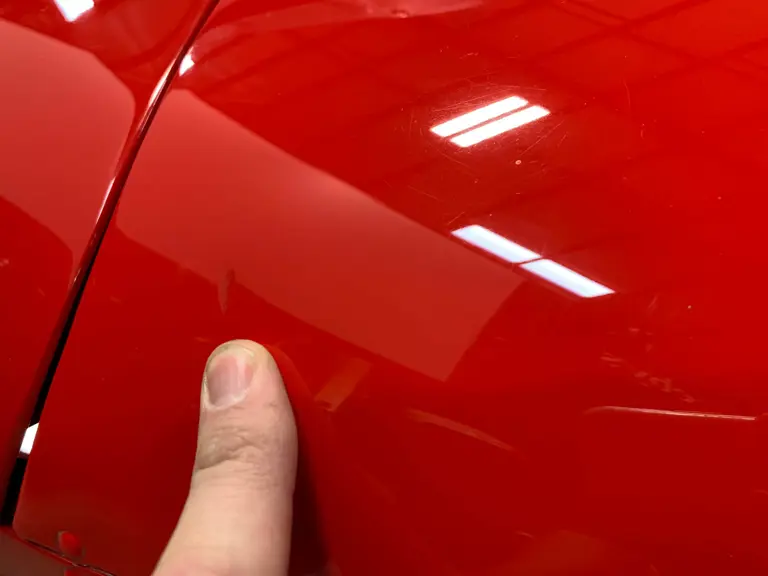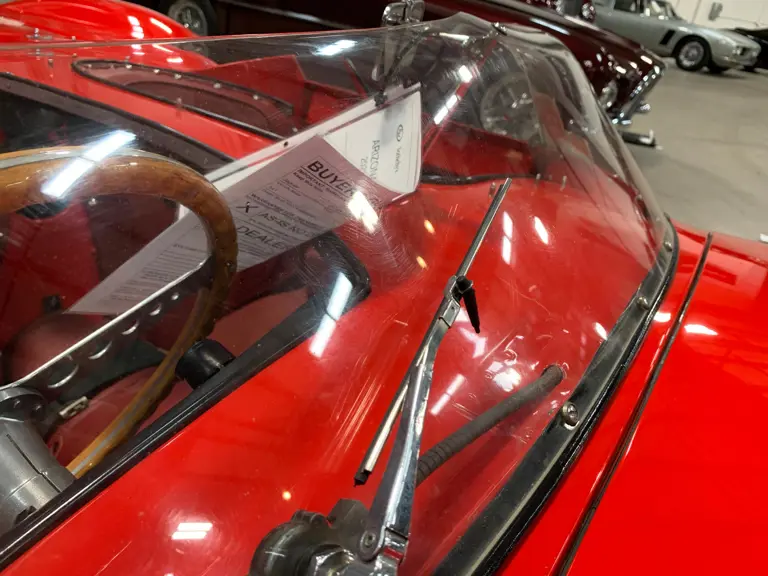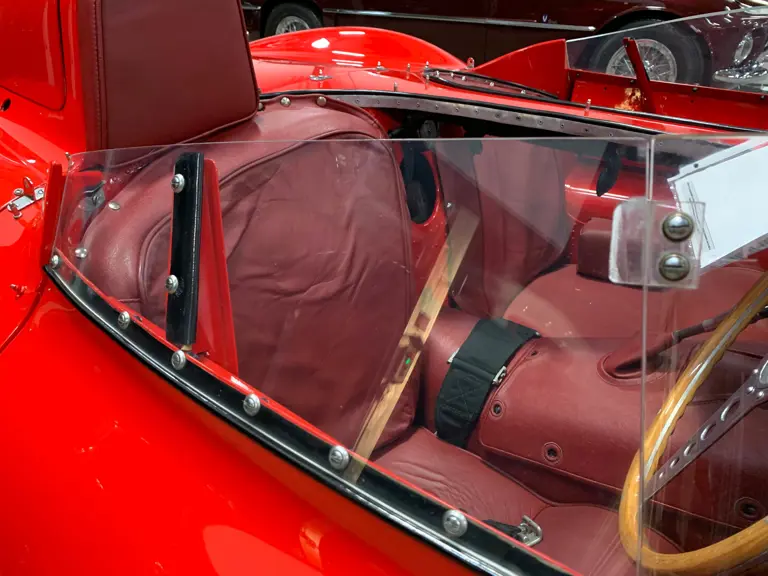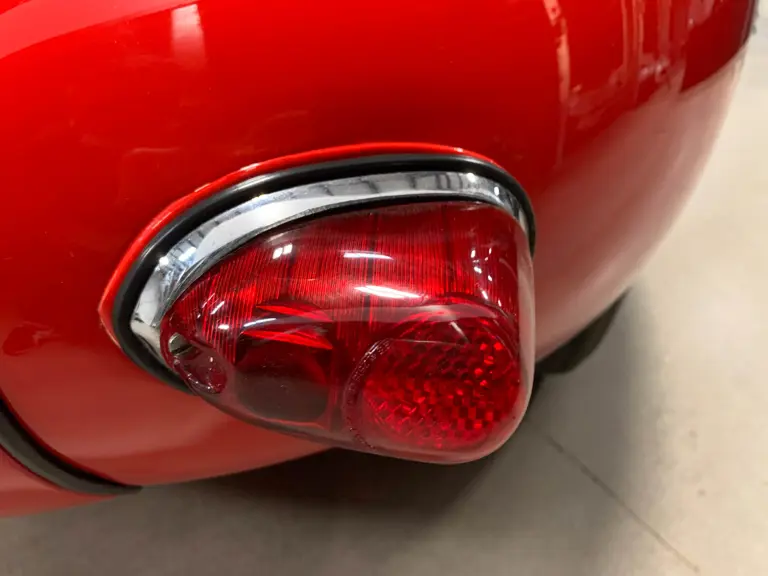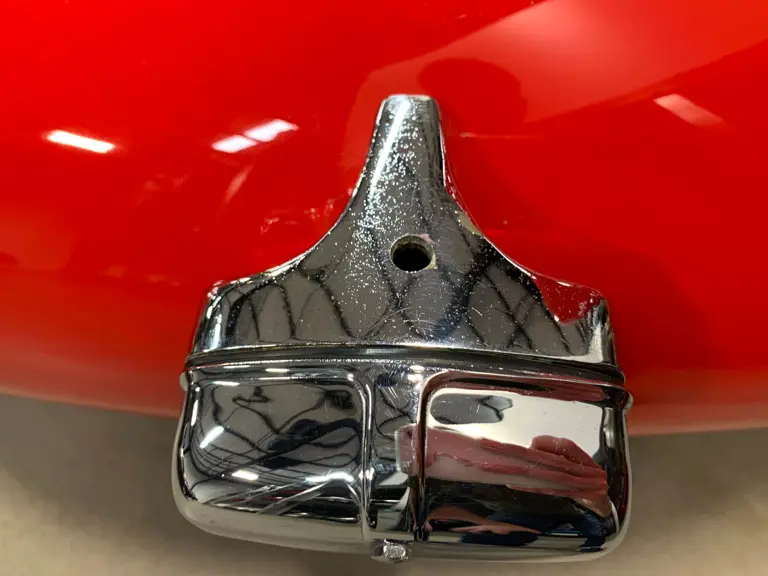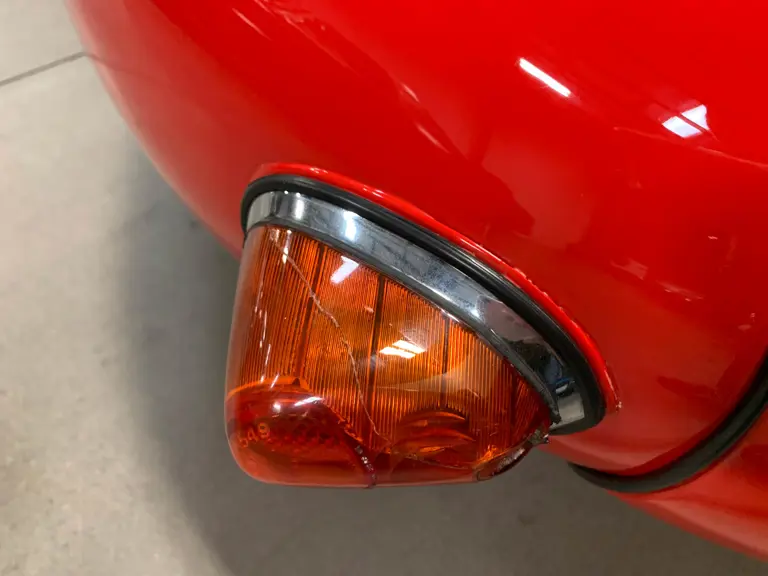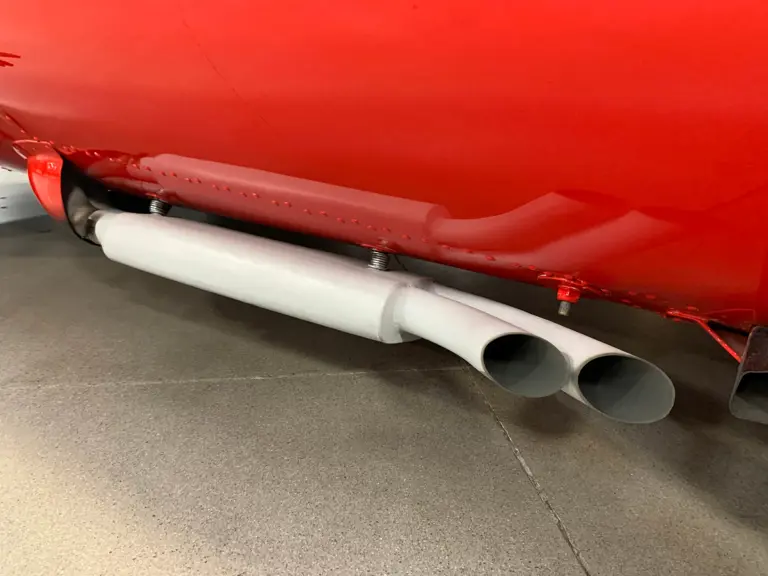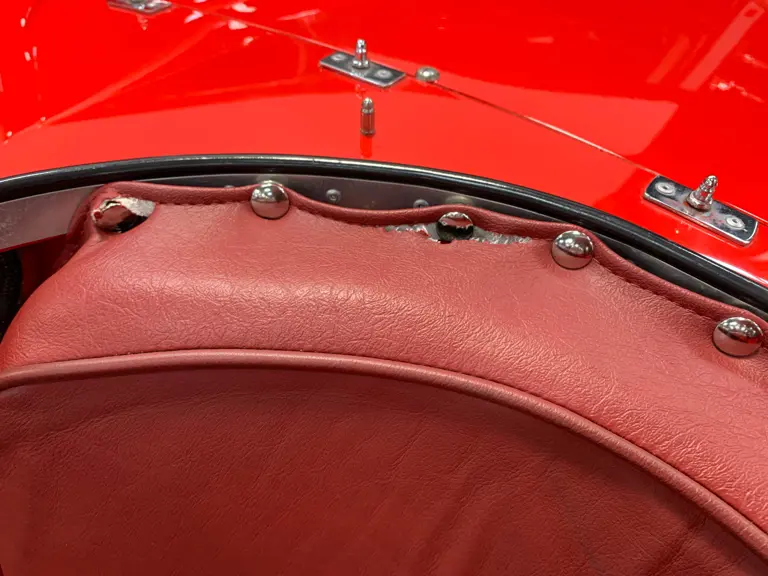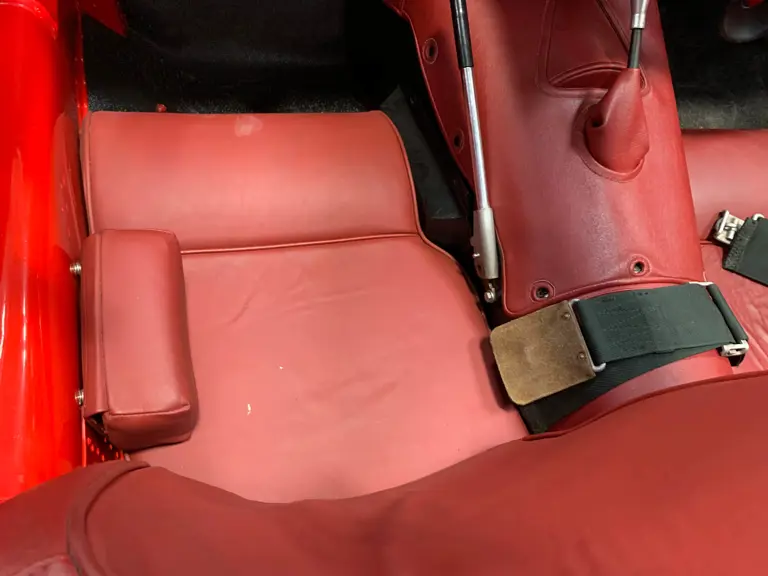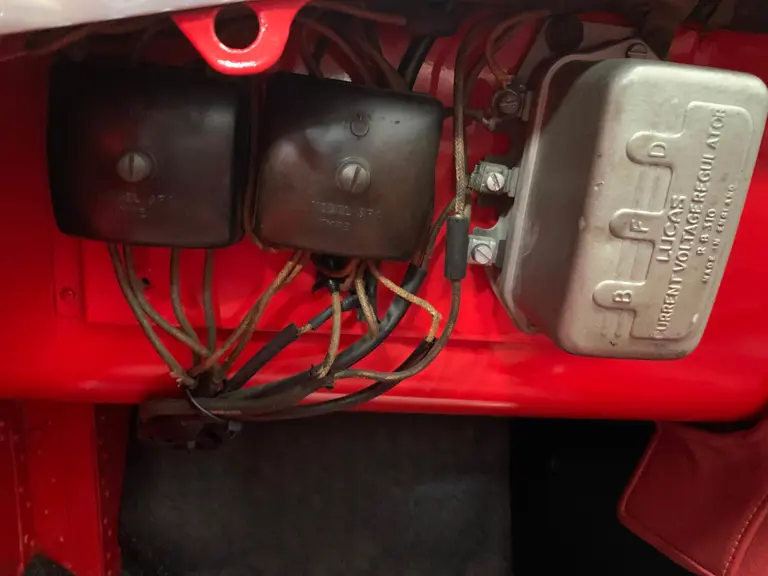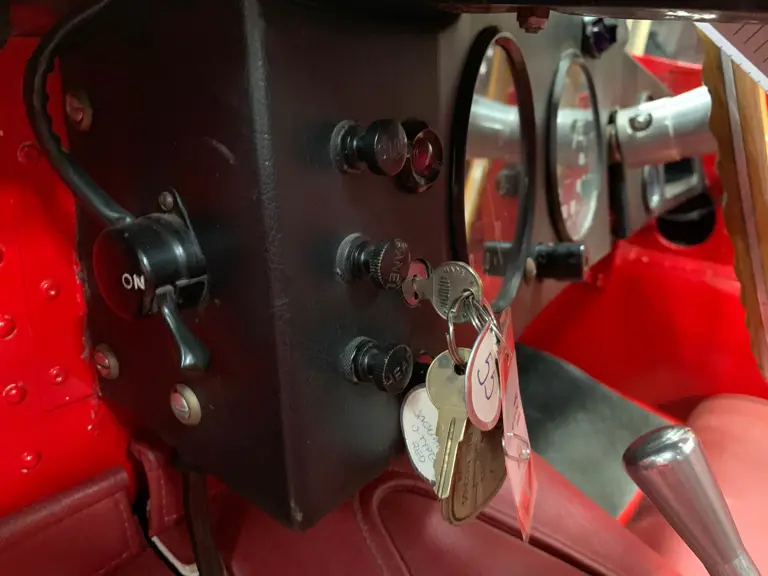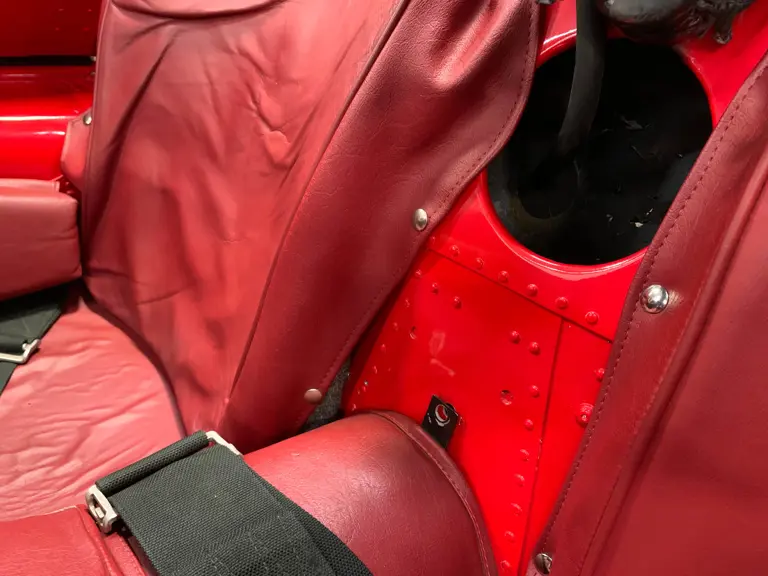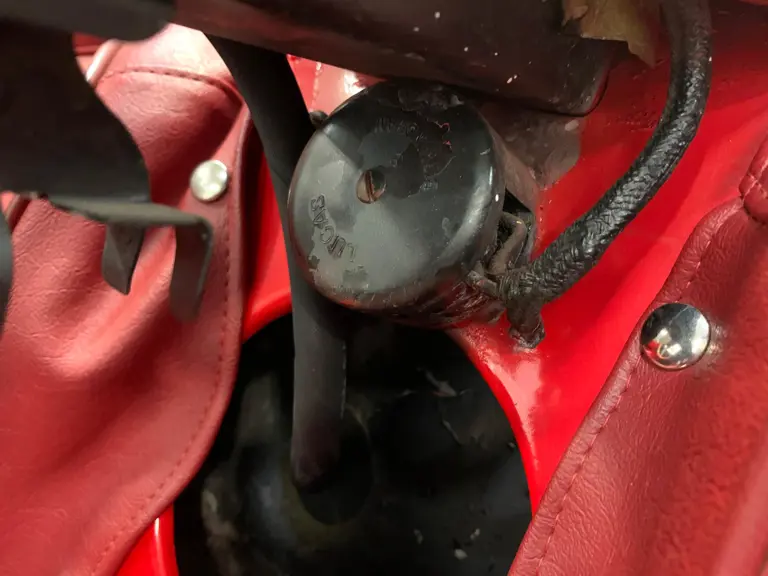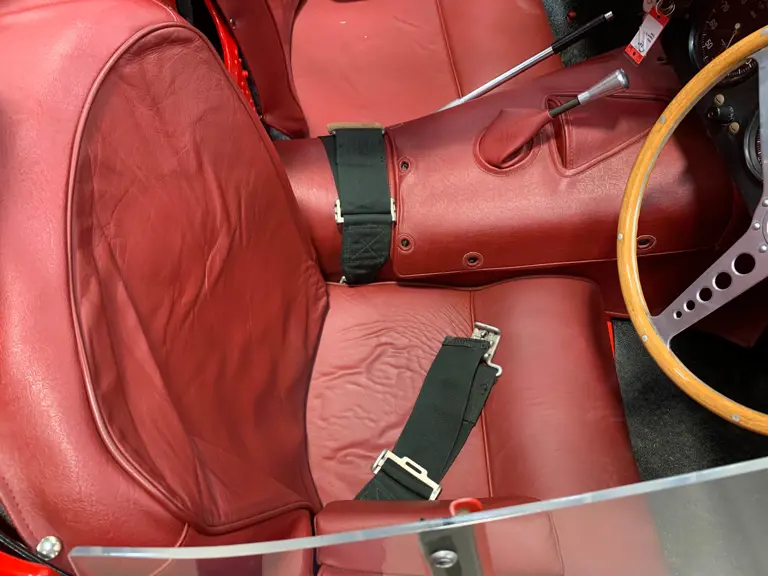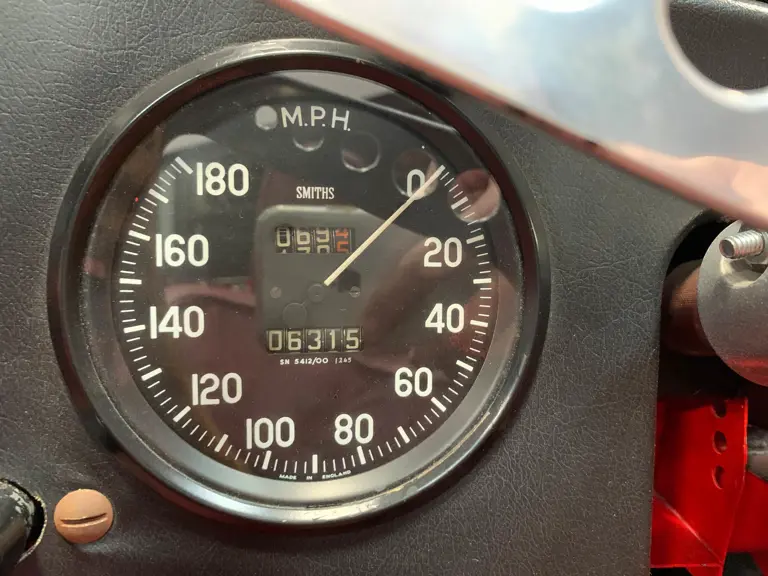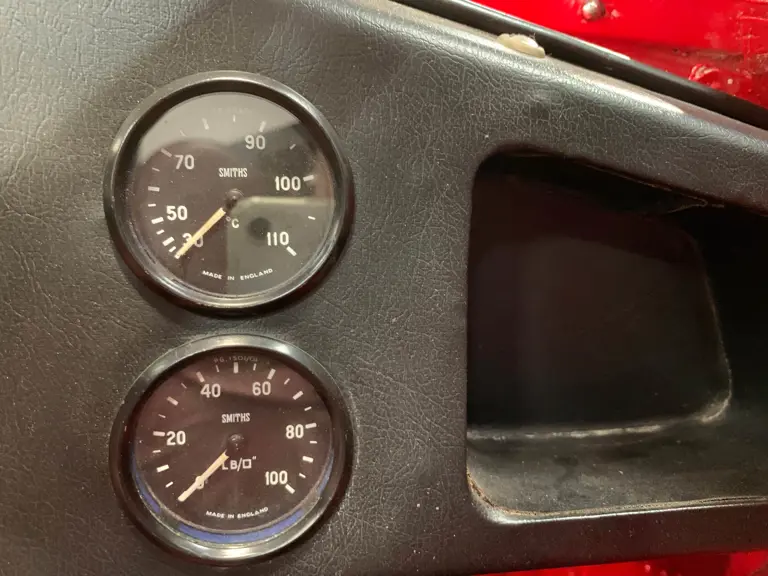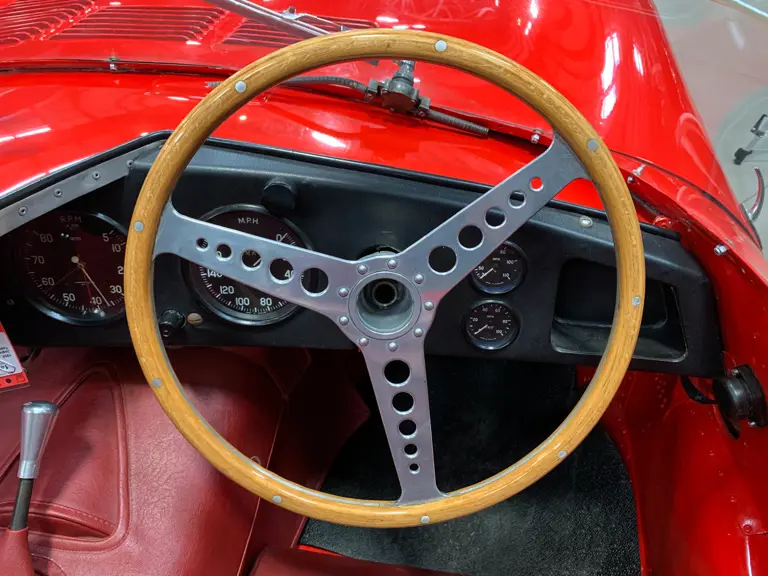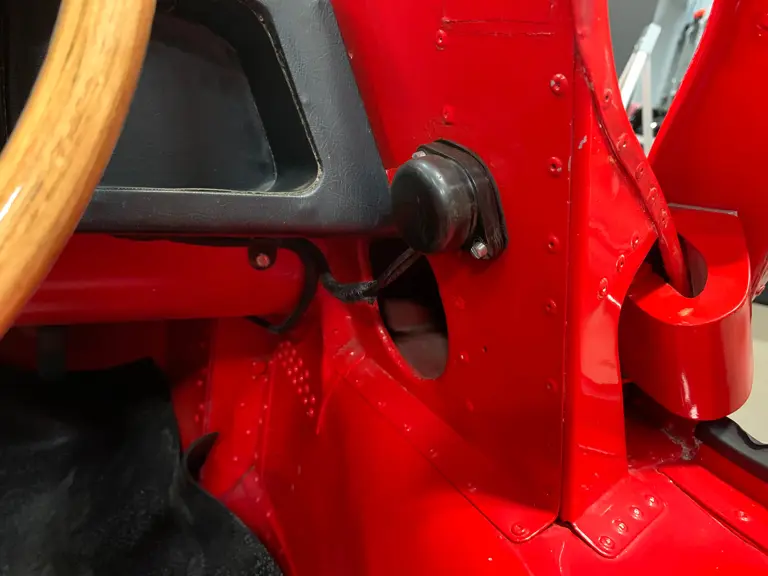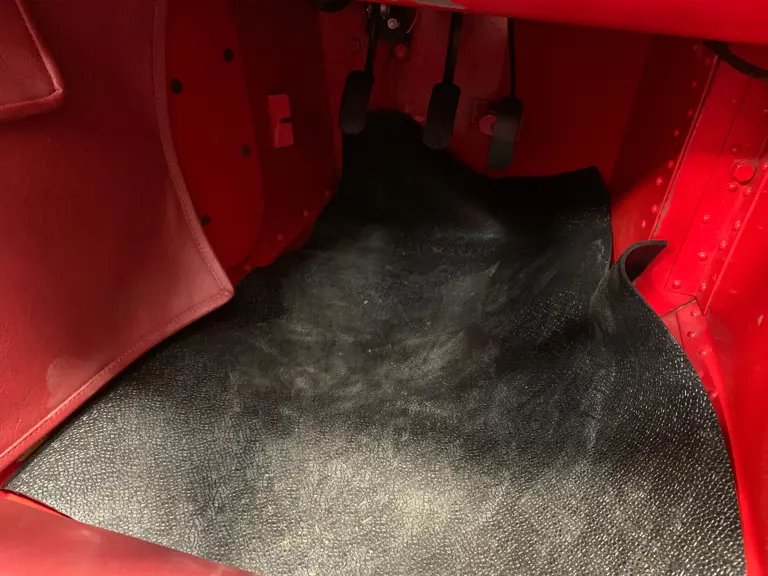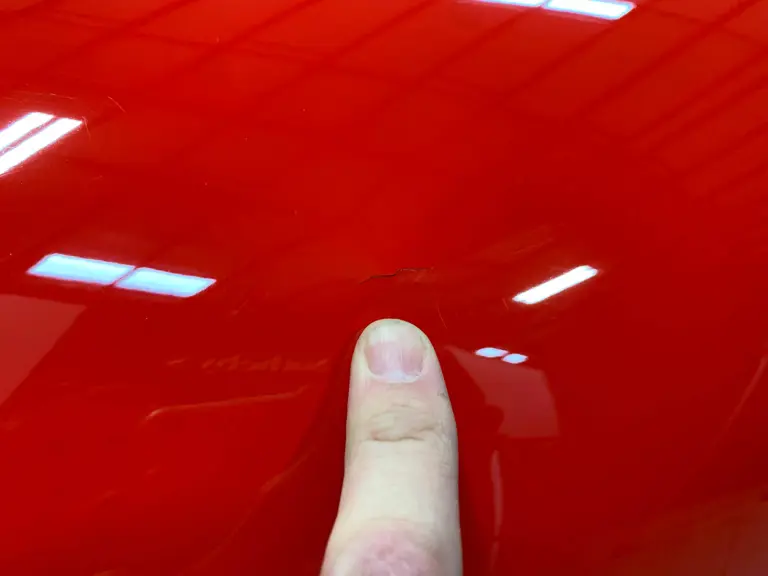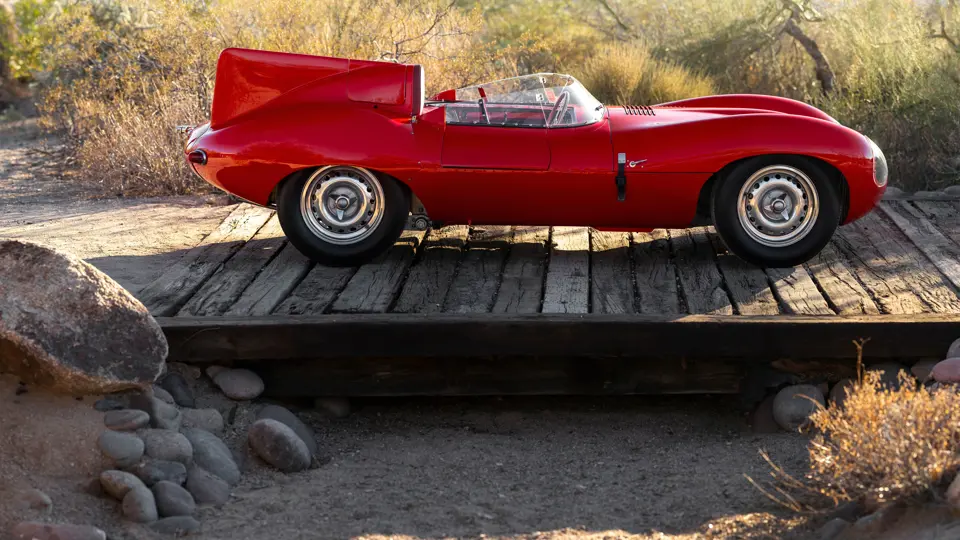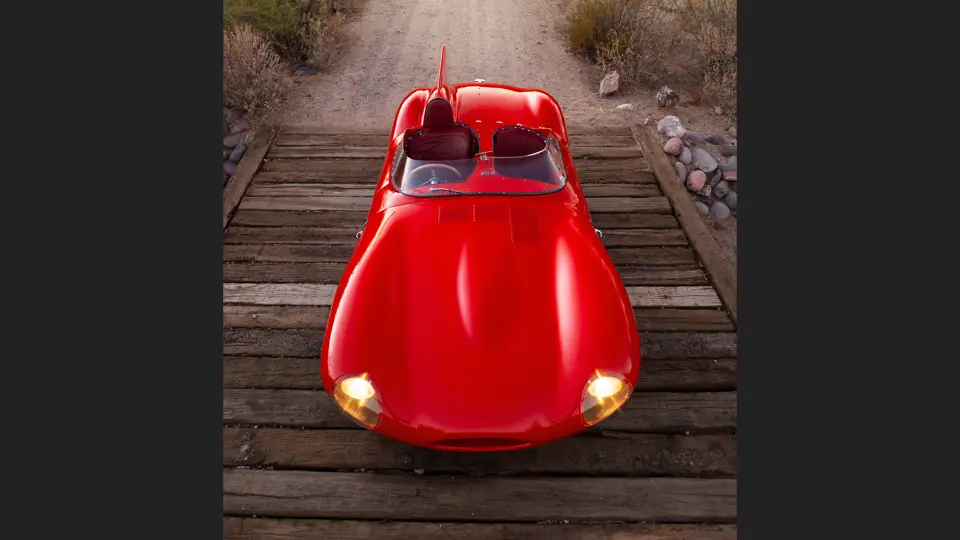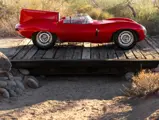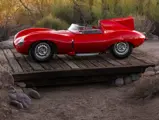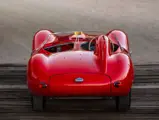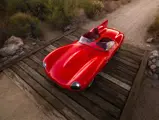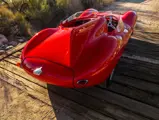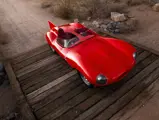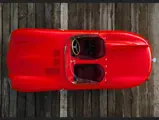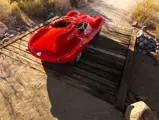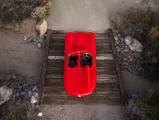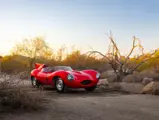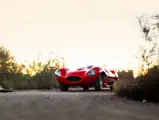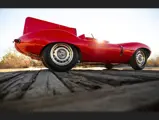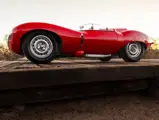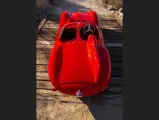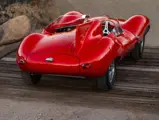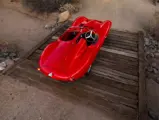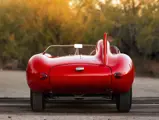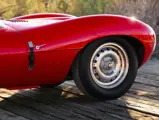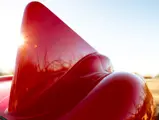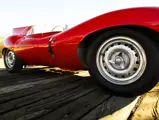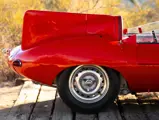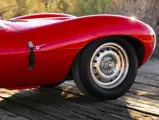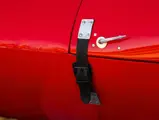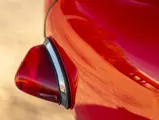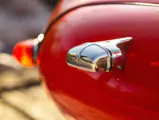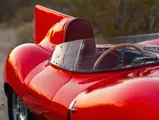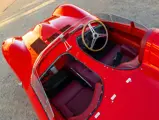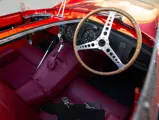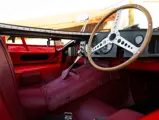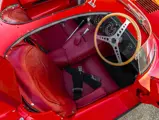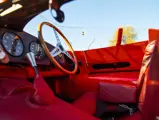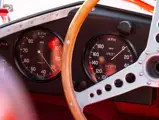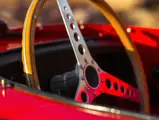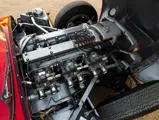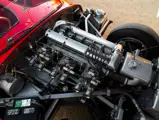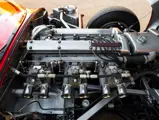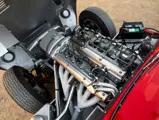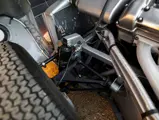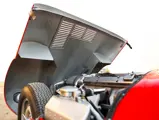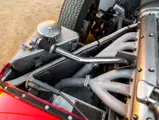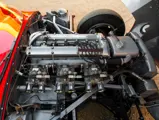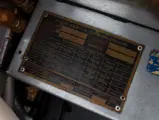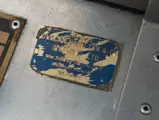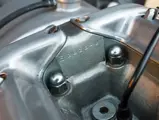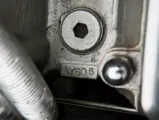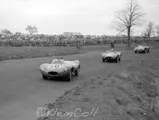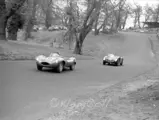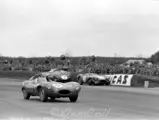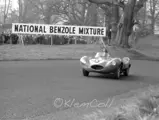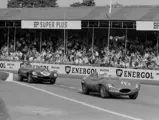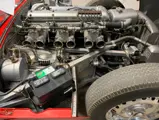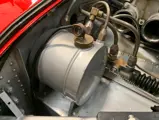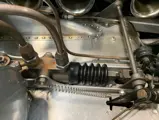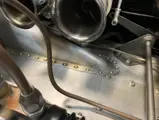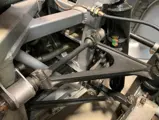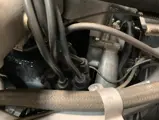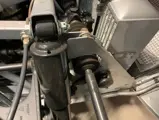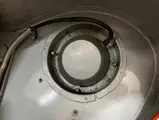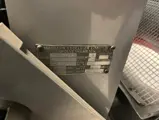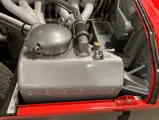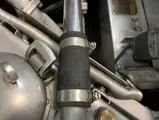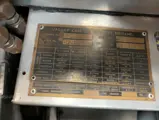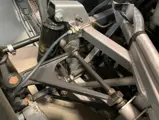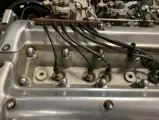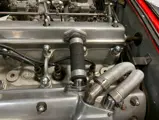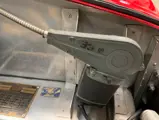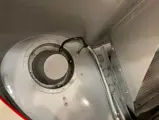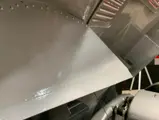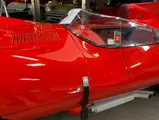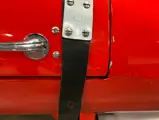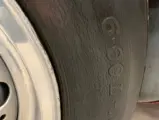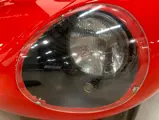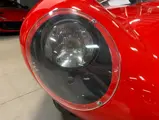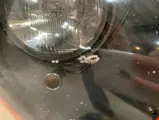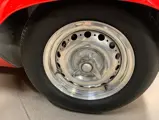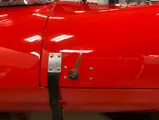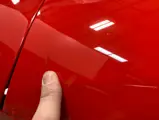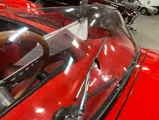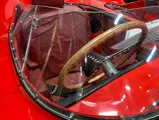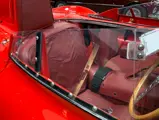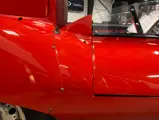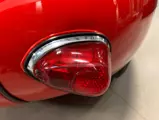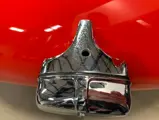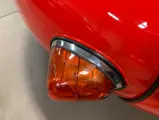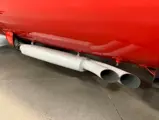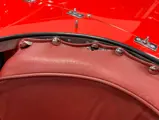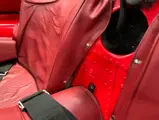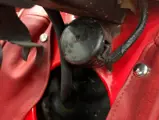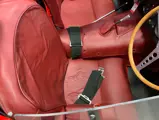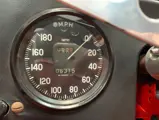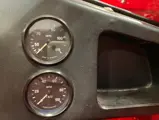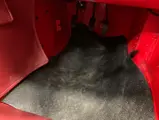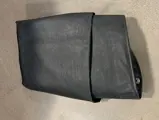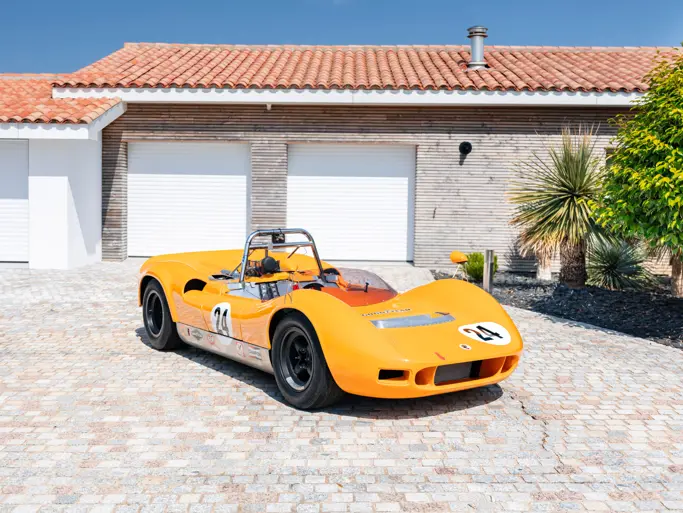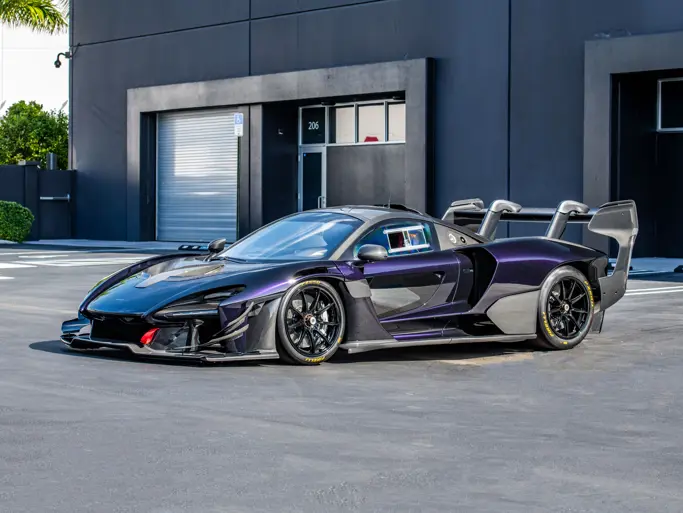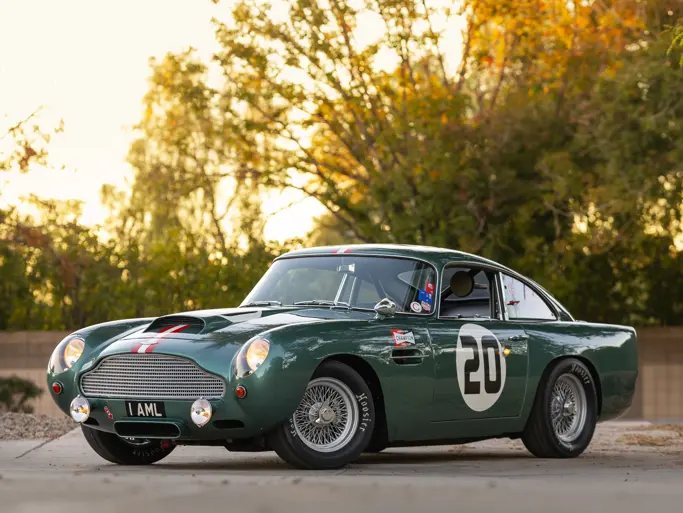
1955 Jaguar D-Type
{{lr.item.text}}
$6,000,000 USD | Sold
{{bidding.lot.reserveStatusFormatted}}
- A well-documented example with substantial period competition history
- Retains many original components, including bodywork and matching-numbers engine and cylinder head
- Offered in its rare, distinctive, and factory-correct Red with Red interior
- Purchased new from Bernie Ecclestone by British racer Peter Blond
- Notable former owners include racer Jean Bloxham and Led Zeppelin manager Peter Grant
THE INDOMITABLE D-TYPE
Following World War II, Jaguar Cars wholeheartedly adopted a time-tested automotive sales strategy: Use feats of speed and competition success to market its civilian sports cars and luxury saloons. First came headline-grabbing speed trials in the XK 120, followed by the model’s success in circuit racing. The XK 120 was then developed into the swoopy C-Type racer; the C-Type’s wins at the 1951 and 1953 24 Hours of Le Mans demonstrated that Jaguar’s investment in motorsport was a very wise one indeed.
Yet if the C-Type represented an evolution of the XK 120, the machine that would follow—the Jaguar D-Type—was a radical leap into the future of performance. With its round haunches and small, oval grille, the D-Type presented a friendly face to the world; behind it, however, lurked a fierce competition car packed with advanced technology.
Unlike its rather conventional predecessor, the D-Type made use of a strikingly modern chassis configuration centered around a strong, lightweight monocoque body tub that enveloped the cockpit. An XK-type dual-overhead camshaft inline-six engine was cradled in a subframe assembly attached to the front of this monocoque; the car’s solid rear axle and rear suspension assembly were correspondingly fitted to the rear bulkhead. While materials and technology have evolved dramatically in subsequent decades, this basic design concept is used on race cars and exotics to this day.
Further forward-looking elements included four-wheel disc brakes supplied by Dunlop, first deployed on the C-Type, and a compact, slippery body that minimized frontal area to reduce aerodynamic drag—an effort aided by the XK engine’s dry-sump configuration and slightly canted orientation, which afforded a lower hood height. Finally, an asymmetric vertical fin positioned behind the driver’s headrest, developed to add stability on circuits with long, high-speed sections (and later added to many initially finless cars, this chassis among them) lent the D-Type an unmistakable profile.
Introduced in April 1954, the D-Type soon earned success in competition: After victory at the 1954 Sebring 12 Hours and strong second-place finish at 1954 24 Hours of Le Mans, the Jaguar works team achieved a first at Circuit de la Sarthe in 1955; Ecurie Ecosse notched a privateer win there the following year. Racing technology evolves quickly, however, and faced with slowing sales, Jaguar decided to use the D-Type chassis it had on hand to build the very similar (though finless) XKSS road car.
D-Type and XKSS production suffered a crippling blow on 12 February 1957, when a fire tore through Jaguar’s Coventry works. Five D-Types were destroyed in the blaze, as well as important tooling and materials. Final D-Type production numbers tallied 17 works race cars (including 11 “long-nose” variants), plus 54 “short-nose” D-Types intended for customers; of that latter group, five were lost in the fire and four were dismantled for parts. A further two of these production D-Types were later converted to XKSS models.
Yet despite the Coventry catastrophe, D-Type’s story was far from over. Notably, five privateer D-Types were entered in the 1957 running of the 24 Hours of Le Mans. They ultimately took the top four places, in addition to sixth place, with the Ecurie Ecosse D-Types famously reprising their 1956 first-place finish and achieving second place to boot. The sleek Jaguar’s place in motorsport history had been secured.
CHASSIS NUMBER XKD 518
Dispatched 29 December 1955 and delivered new to Henlys of Manchester, England, XKD 518’s appearance immediately distinguished it from the already rarified D-Type set. Painted Red with an interior trimmed to match, it was one of a very small number of D-Types (perhaps as few as two or three examples) to be so finished when new. One historian suggests, somewhat humorously, that this unexpected livery was selected by Jaguar in hopes of breaking into the Italian privateer racing market.
Whatever the motivation may have been, the car remained in England, and racer Peter Blond became its first private owner—having purchased the car for £3,500 from a certain Bernie Ecclestone, who had taken the car on after Henlys failed to find a buyer. Blond soon put it to good use in club racing, achieving second and first place finishes at Snetterton in June 1956, along with another first at Snetterton in September. Other appearances in busy 1956 and 1957 seasons included Aintree, Silverstone, Oulton Park, and Goodwood, where Blond competed in the Goodwood Trophy race and finished ninth.
Blond sold the car to Jonathan Sieff in August 1957; Sieff continued to race the car with Blond, with a best recorded finish of second at Full Sutton in July 1958. Following the 1959 racing season Sieff sold to the car to Monty Mostyn of Speedwell Garage, and after a brief period in the hands of John Houghton, it was acquired by racer Jean Bloxham. Bloxham brought the car to Goodwood in March and April of 1961 and raced the car at Silverstone in May, finishing third in one of her outings.
XKD 518 returned to John Houghton in around 1962, and around 1967 it was sold on to John Coombs and Richard Wilkins. Under the care of its next owner, Clive Lacey, it attended the first International E-type Day at Donington Park in 1974. Following Lacey, this D-Type was purchased by Led Zeppelin manager Peter Grant.
The car crossed the Atlantic in 1982 after its purchase by American collector George Stauffer, who retained the D-Type until 1996. From Stauffer it passed to Chris Cox, then in 1998 to Roger Willbanks, before being acquired by Bill Jacobs in 2005. It has resided in the collection of its current owner and consignor since 2008. Importantly, there are no known breaks in XKD 518’s record of ownership or gaps in its history, and the car is included in authoritative marque and model texts including Jaguar Sports Racing Cars: C-Type, D-Type, XKSS and Lightweight E-Type and Jaguar C-Type. D-Type & Lightweight E-Type Register.
Painted British Racing Green at some point in its past, XKD 518 has since been returned to its factory Red. Inside the remarkably low-slung cockpit, the correct red interior upholstery found on the lap belt-equipped seats continues on the transmission tunnel. The car’s two seats are a separated by a divider, a feature eliminated on the XKSS road cars; a purposeful wood-rimmed steering wheel—all D-Types were right-hand drive—sits in front of a suite of Smiths gauges. A black tonneau cover provides a degree of weather protection when parked.
Initially built with a narrow windscreen and no tailfin behind its headrest, XKD 518 was, as car engaged in regular racing, upgraded as D-Type design was honed by competition. Currently, the car is fitted with a full-width windscreen, a configuration shown in some period photographs; precisely when it gained its distinctive tailfin remains unknown.
Underneath the car’s aerodynamically sculpted bonnet, fittingly secured by leather straps, sits the numbers-matching 3.4-liter dry-sump XK engine (both block and cylinder head are stamped E 2028-9). Fed by triple Weber carburetors, breathing through passenger-side-mounted exhaust, and mated to four-speed transmission, this combination was rated at 245 horsepower when new. Meanwhile, at the very tail of the car, a full-size spare wheel is hidden away in small boot; the fuel filler cap is similarly concealed from sight in a compartment behind the driver’s headrest at the base of the tailfin.
Advanced in design and construction and highly successful in competition—while also distinguishing itself as one of the most aesthetically pleasing racing machines ever devised—any Jaguar D-Type is an important and notable vehicle. Beyond its distinctive color combination, XKD 518’s particular appeal lies in its well-documented provenance, including a healthy record of in-period racing. Further, despite ample time spent on circuits, it has survived to the present accompanied by its original engine, cylinder head, and bodywork. Needless to say, not all competition machinery from racing’s golden era has been so lucky.
A compelling centerpiece for any serious collection of significant sports and racing cars, XKD 518 is also a worthy candidate for vintage competition at the highest and most prestigious levels; it awaits a dedicated owner prepared to carry on the legacy established by racers and enthusiasts in the decades since this special D-Type first left Coventry.
